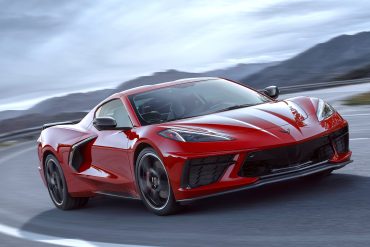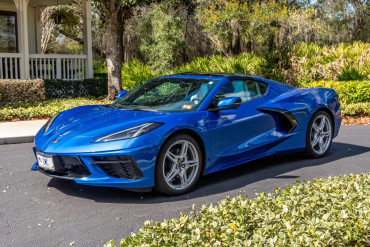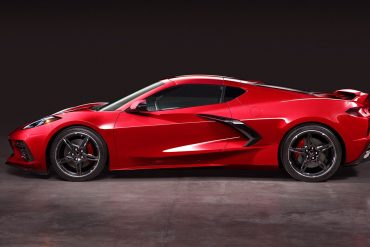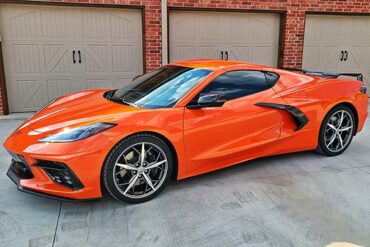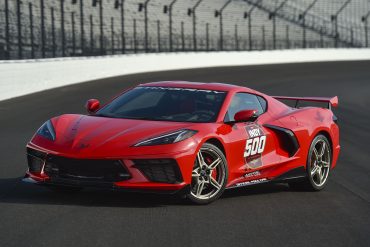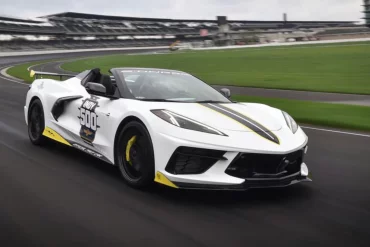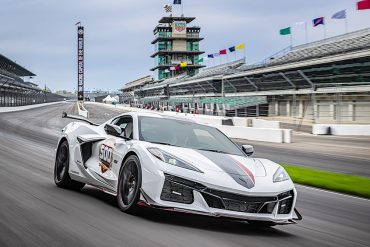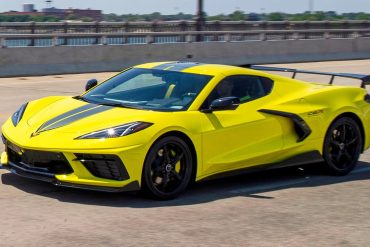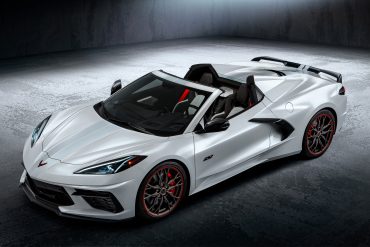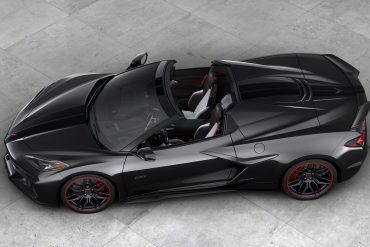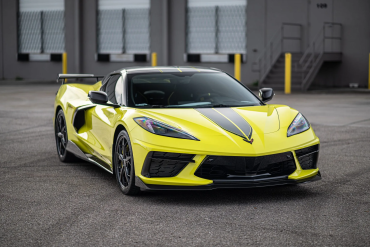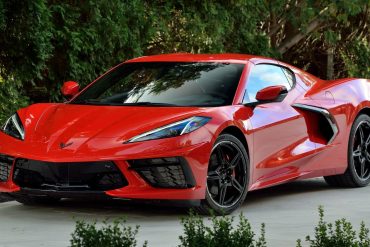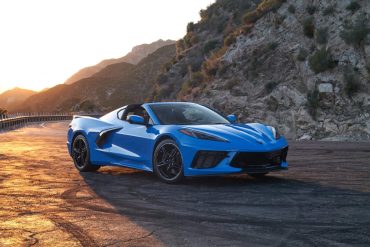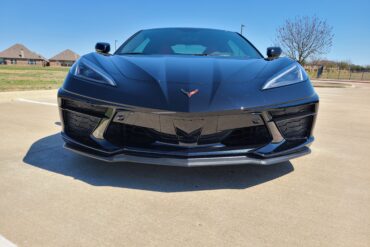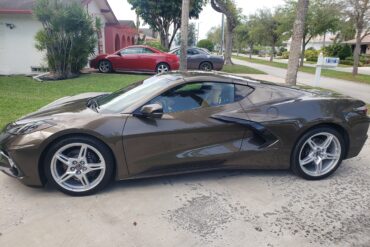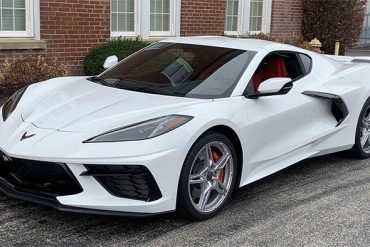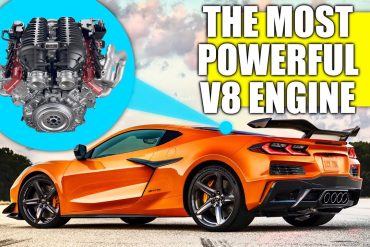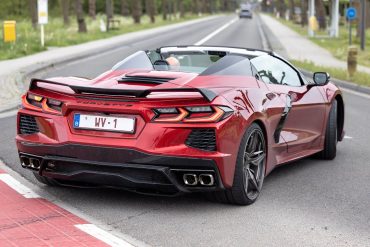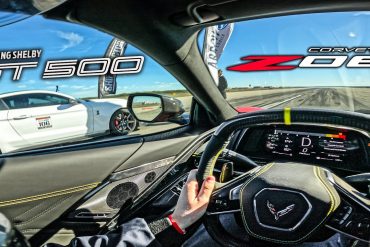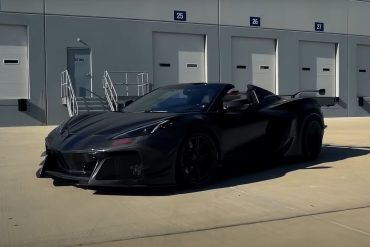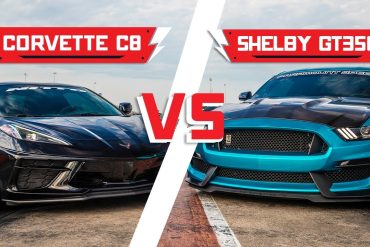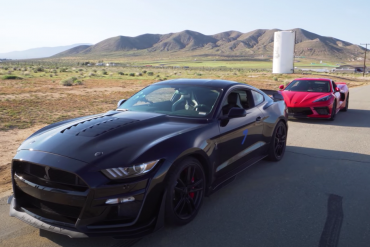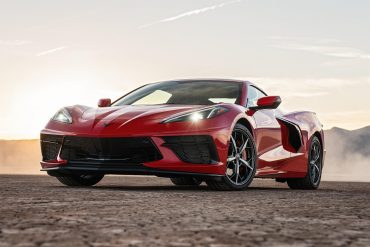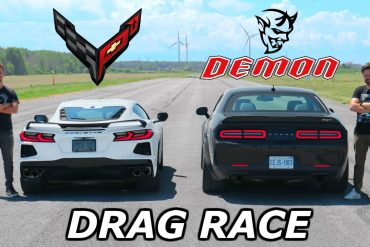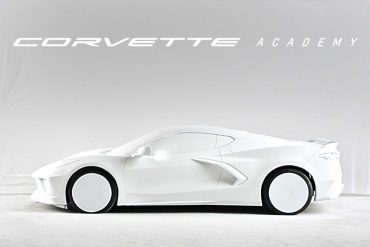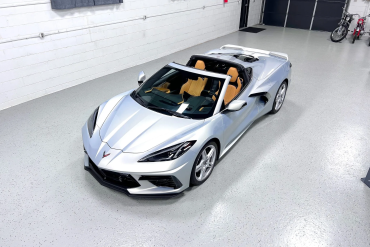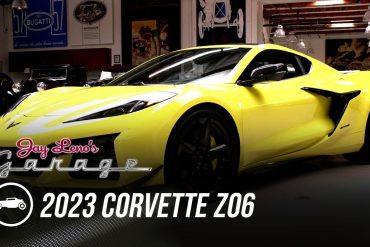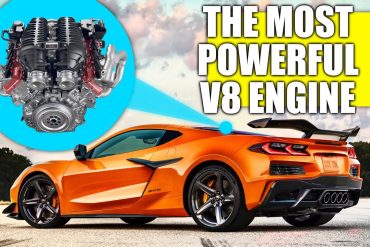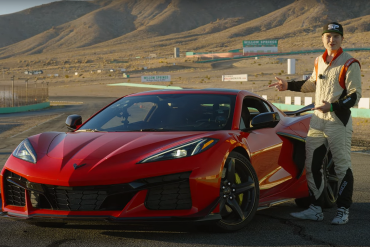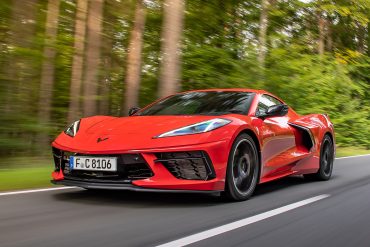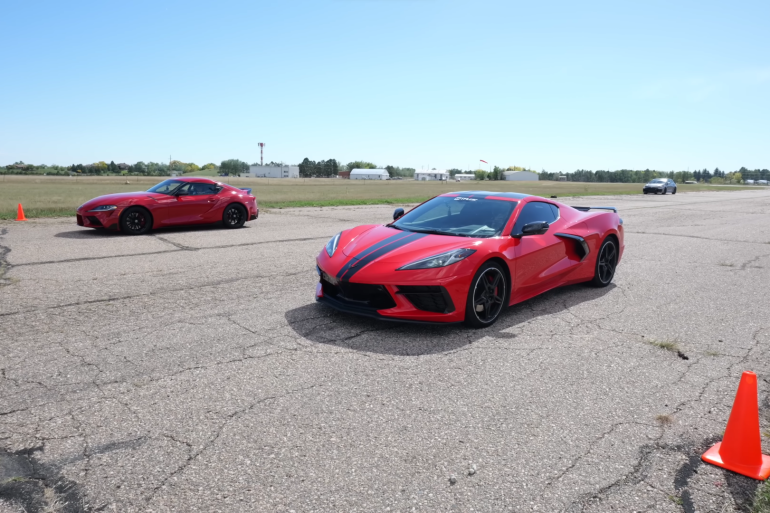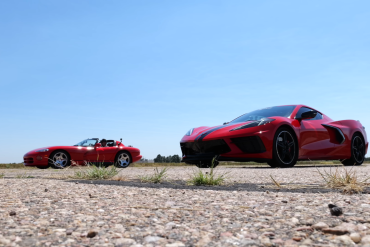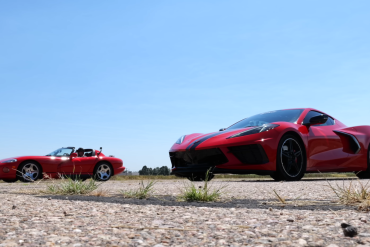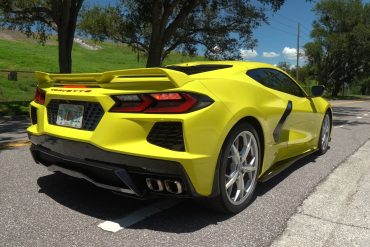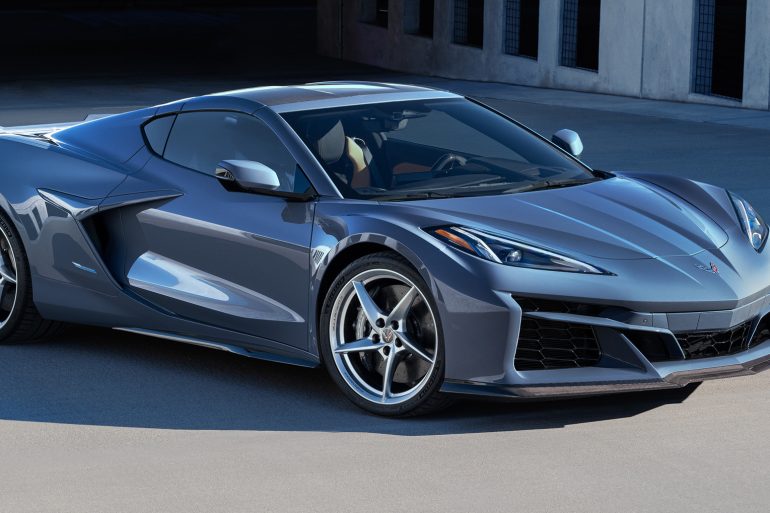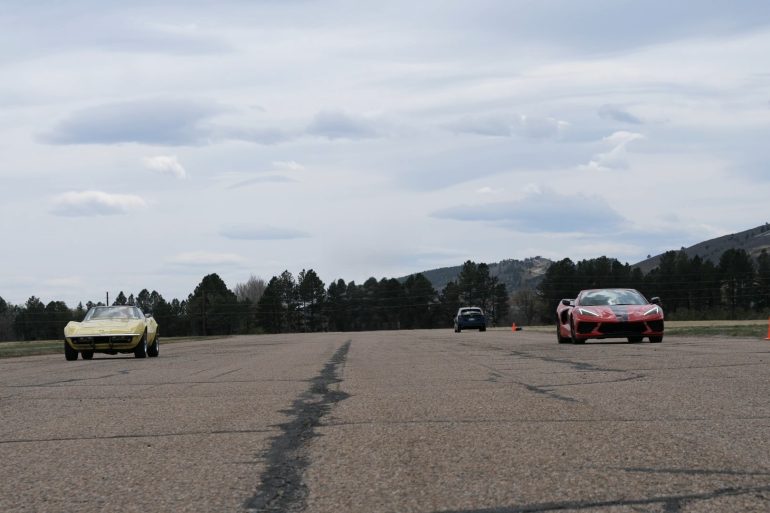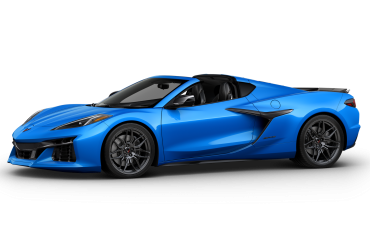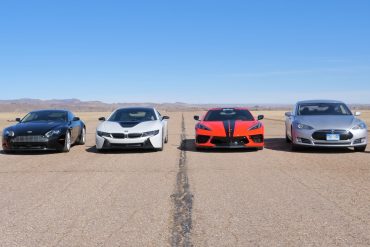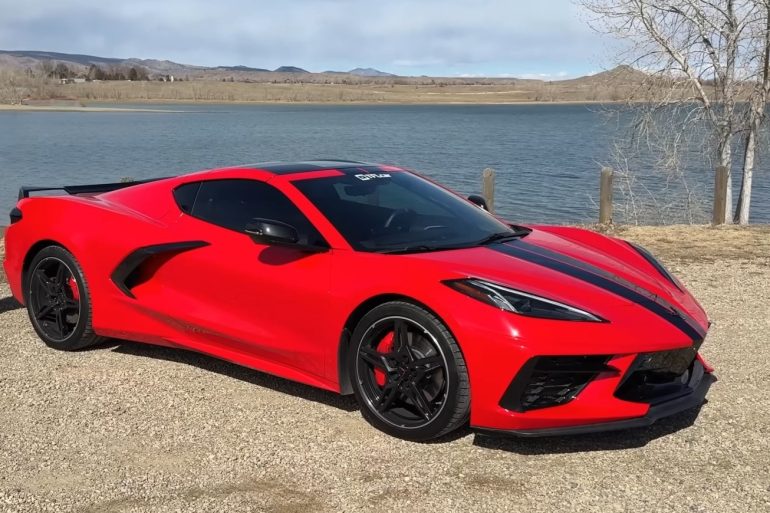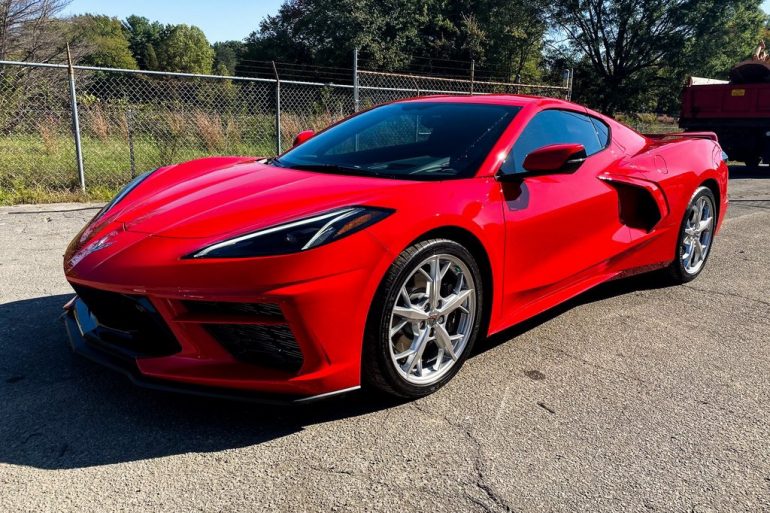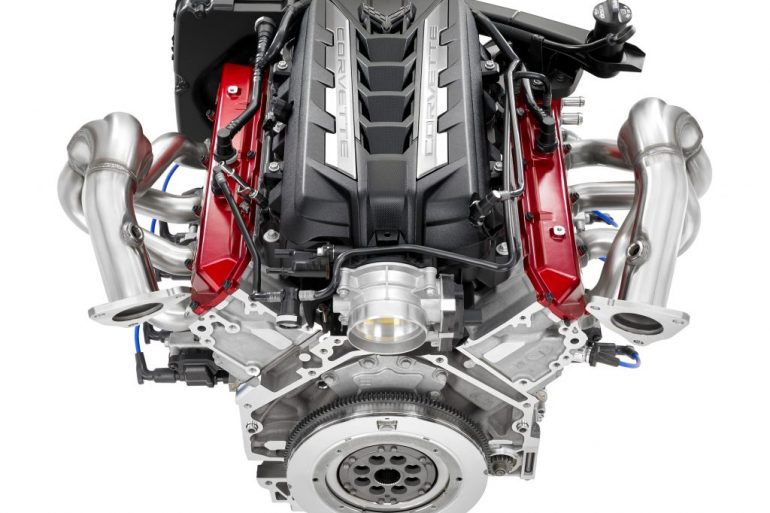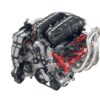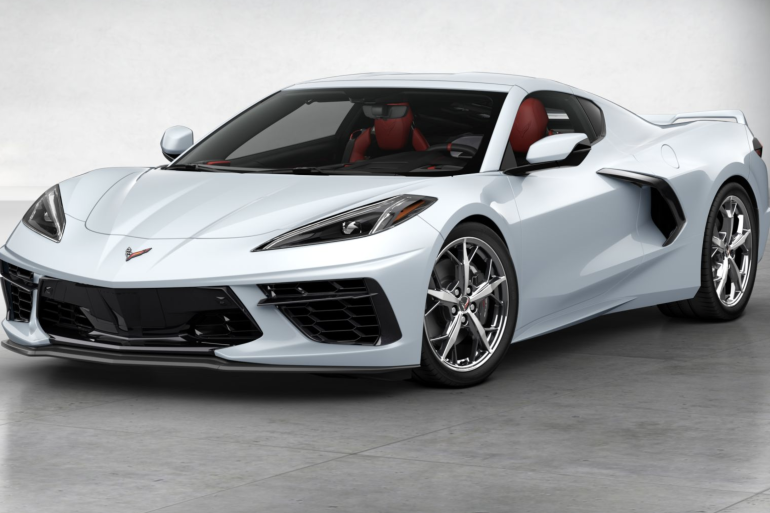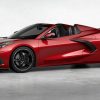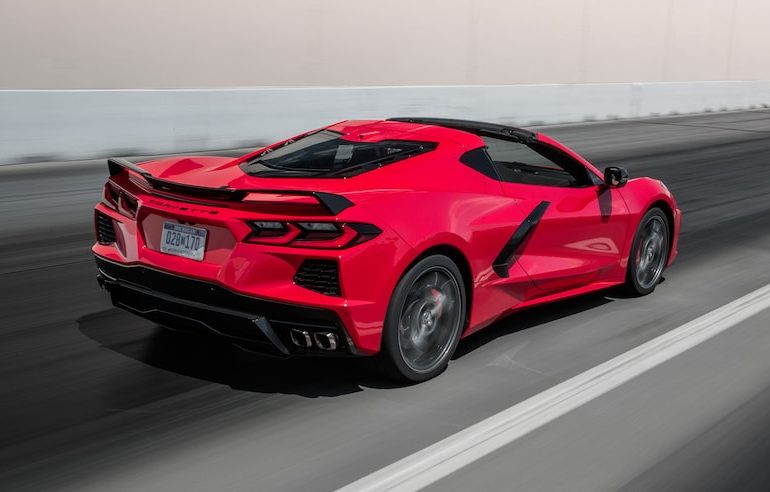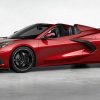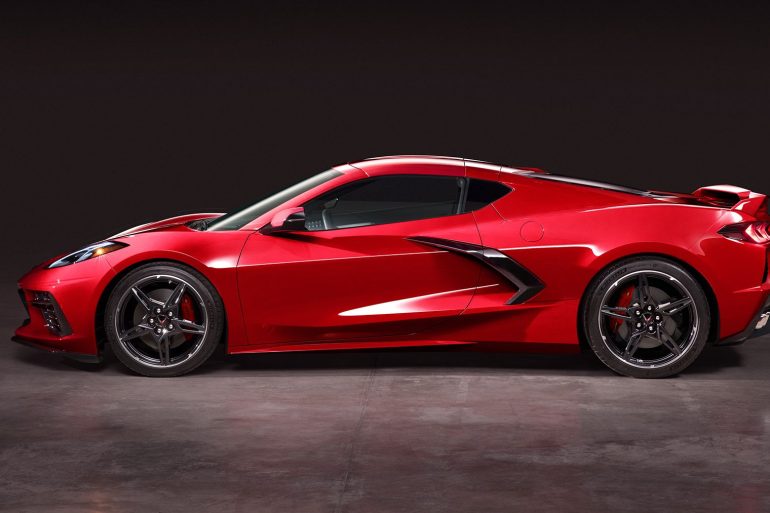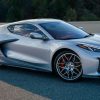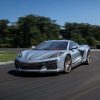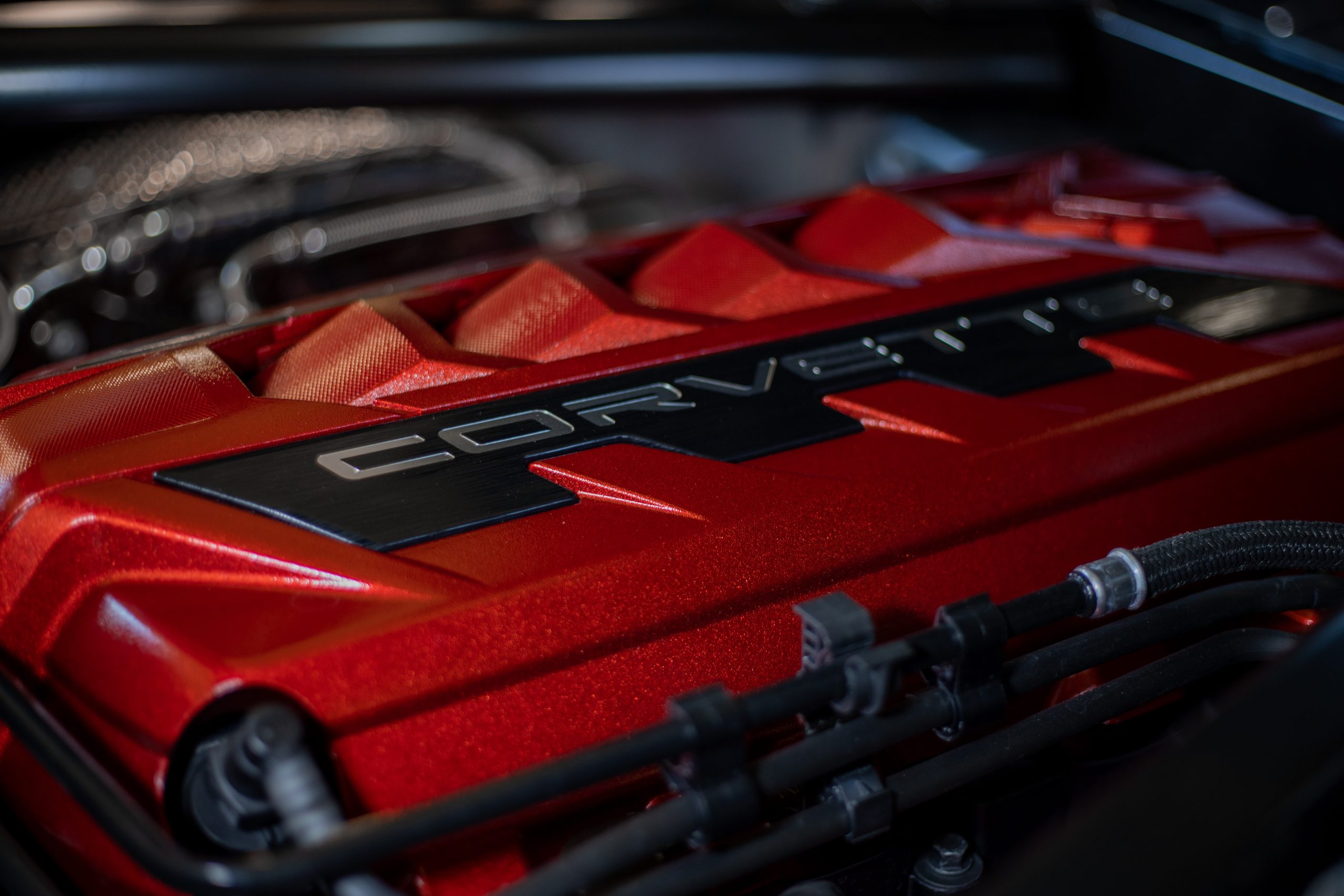C8 Corvette - “One Man’s Vision Finally Becomes Reality”
Research & Complete Reference Guide
Basics / The Story / MY Research / MY Guides / The Market / Vids & Pics / Latest / Tech Research
The Mid-Engined Corvette
Long before the formal introduction and unveiling of the C8 Corvette by Chevrolet on July 18, 2019, one man’s dream of building a mid-engine Corvette fueled the imagination of countless others and helped turn that dream into reality. Generations of GM engineers and designers, many of whom had the distinction of working with the late, great Zora Arkus-Duntov during his decades-long career with Chevrolet, shared in his vision of transforming the Chevy Corvette into a mid-engine racer that would not only rival Porsche and Ferrari on the racetrack, but dominate them on the open road as well.
Ironically, Zora’s singular focus to develop a mid-engine variant of his beloved sports car dates back almost to the beginning of the Corvette program itself. Little could he – or any of us – realize that it would take more than sixty years and seven-generations of front engine, rear wheel drive Corvettes before that dream would become a reality.
In order to more fully appreciate the Herculean effort behind the creation of the C8 Mid-Engine Corvette Stingray, we must give credit to the cars that helped paved the way to its creation. It is important to understand that, almost from its very start, the vision for Corvette was that it would eventually evolve into a mid-engine automobile. This is significant in that there is a subset of Corvette purists who have condemned the new C8 as being an abomination, claiming that GM has ruined their flagship automobile in the interest of building a car that will compete with its European counterparts but which no longer holds true to the character that made the Corvette such an iconic American sports car. However, if we actually look at the history of the Corvette, we discover that this statement couldn’t be further from the truth…but we don’t just expect you to take our word for it!
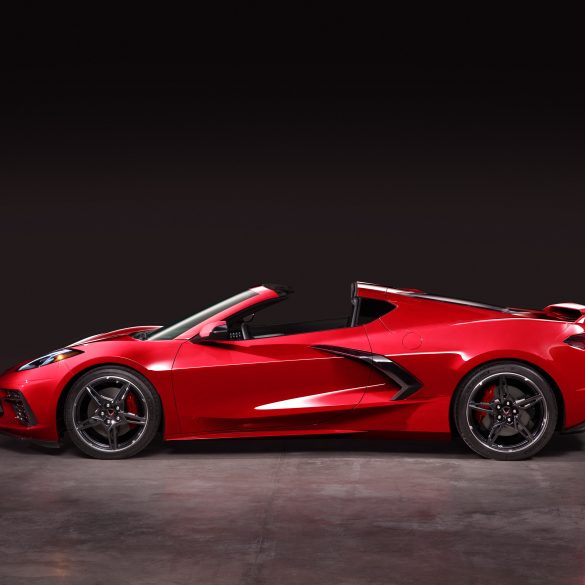
C8 Corvette Basics
Generation: C8 Corvette / Body Styles: 2 Door Coupe & Convertible / Production: 2020 - Present / Model Years: 2020, 2021, 2022, 2023
Evolution of a Mid-Engine Corvette
Here is a brief (and by no means complete) list of mid-engine prototypes – many of them developed by Corvette’s lead engineers over the years – that demonstrate just how long Chevrolet has considered manufacturing a mid-engine Corvette:
CERV-I (Chevrolet Engineering Research Vehicle) – Zora Arkus Duntov started development of the “CERV I” in 1959. The car was unveiled to the public at the Riverside International Raceway in November, 1960. The car was developed as a research tool by Chevrolet to advance the company’s continuous efforts to understand automotive ride and handling phenomena under the most realistic driving conditions. The car was built at the Chevrolet Engineering Center in Warren, Michigan.
CERV-II (Chevrolet Engineering Research Vehicle) – Zora Arkus-Duntov began work on the CERV II in 1963 and completed it in 1964. The original plan was to build six cars, three for competition and three spares. The body was styled by Larry Shinoda and Tony Lapine, the former of which would go on to help develop a number of other mid-engine Corvette prototypes. To achieve superior performance, the car was built on a monocoque chassis and was powered by a 377 ci all-aluminum SOHC V8. The engine featured Hilborn fuel injection and was rated at 500 hp (370 kW). Testing of the car resulted in a recorded top speed of 210 mph (338 km/h), and a 0-60 mph time of just 2.8 to 3.0 seconds. The car featured a two-speed transmission on each of the front and rear axles, with transferable torque between axles.
1964 XP-819 – While some might argue that the CERV I and II were strictly test-mules for emerging technologies, the XP-819 was developed by Duntov to demonstrate what the potential of a mid-engine variant of the Corvette could look like. It was also created to prove that Chevrolet could compete with European automotive manufacturersrs who had already produced several mid-engine sports cars with great success. Despite being the brainchild of Duntov, the car was not well received by GM’s top brass after its introduction.
1970 XP-882 – Chevrolet introduced their first official Corvette prototype – the XP-882 – at the New York Auto Show in 1970. The car was so well received that Chevrolet advanced the concept vehicle nearly to the point of production. However, the high costs associated with developing a mid-engine variant of the Corvette caused then Chevrolet General Manager John DeLorean to order a stop-work on the XP-882 in favor of continuing production of the C3 Corvette to ensure product profitability.
The 1986 Corvette Indy/ 1990 CERV-III – In 1986, Chevrolet introduced the “Corvette Indy”, which featured a mid-mounted twin-turbo V8 engine and all-wheel-drive. However, this model was a pure concept car, and did not feature many of the essential options found on almost all production vehicles. In 1990, Chevrolet introduced the CERV III which was a fully featured variant of the Corvette Indy. However, declining sales of the C4 Corvette and an overall financial slump in Detroit once more caused Chevy to shy away from advancing the CERV III beyond a concept vehicle.
2002 Cadillac Cien Concept Vehicle – First introduced at the 2002 Detroit Auto Show, the Cadillac Cien was incredibly well received by both the automotive press and the public. The real attraction of the Cien was the powerplant that was packaged behind the car’s cockpit – a 7.5L V12 engine rated at 750 horsepower. While this car was not built as a prototype for the Chevy Corvette platform, the development of this vehicle proved beyond doubt that General Motors was focusing their attention on the development of a mid-engine sports car.
Corvette Zora
The earliest evidence that General Motors was developing a mid-engine Corvette started to surface in 2014, and then only in rumors and second-hand reports from “insiders” within Chevrolet. It was no secret that GM was already looking beyond the C7, even though the seventh-generation Corvette was brand-new that year.
At a late-May event intended to promote the Chevrolet Detroit Belle Isle Grand Prix, Mark Reuss, General Motors Head of Global Product Development, confirmed that the company was already at work on the next-generation Corvette. While Reuss’s comments were admittedly vague, he indicated that Chevrolet was looking at potentially developing a hybrid or all-electric Corvette, and also eluded that the next-generation Corvette would be revolutionary.
Almost overnight, the automotive community became abuzz with rumors that Chevrolet was beginning development of a mid-engine Corvette. With the C7 still in its infancy, GM engineers and designers were remiss to provide any information that might provide even minor clues to the future of the Corvette program.
On September 25, 2014, Car and Driver Magazine published an article titled “C8 Chevrolet Corvette Exclusive! What to Expect from the Heart-Stopping, Mid-Engined Zora!” The feature-length article claimed to have “serious dirt on GM’s secret mid-engined supercar” and featured several renderings of a car that the article referred to as the “Corvette Zora.” Don Sherman, author of the article, opened the piece with the bold claim, “The new Corvette will be the mid-engined American Dream Machine that Chevy couldn’t, until now, muster the courage to build.”
The Car and Driver piece actually presented some compelling claims as to why a mid-engine Corvette made sense for the future of the brand. Sherman argued that the C7 Corvette, especially the Z06 edition of the car, had maxed out the Corvette’s potential as a front-engine, rear-wheel drive automobile. He further suggested that “moving the engine’s mass closer to the drive tires is the most effective means of improving Corvette acceleration and braking.” While both of the points were valid, he made another compelling argument for the evolution of a mid-engine Corvette had nothing to do with engineering.
Sherman pointed out that the Corvette had used the same basic proportions and “form language” since the birth of the C3 Corvette in 1968. While the evolution of the Corvette had certainly improved its capabilities, offering drivers ever-increasing horsepower and driveability, Sherman argued that the C7 Corvette Stingray was a “dream car for men on the wrong side of 50.” He believed that introducing a mid-engine Corvette with a vastly updated exterior would capture the imaginations of adolescents already obsessed with European super-cars like the Lamborghini Aventador, the Ferrari LaFerrari, the McLaren P1 and the Porsche 918.
While the renderings of the Corvette Zora in the article offered enthusiasts an exciting first glimpse at what a mid-engine Corvette could be, there was considerable speculation as to the accuracy of the pictures and, more importantly, the delivery dates that the article claimed as factual. Would the Corvette Zora actually be released as a 2017 model year automobile? Given the young age of the C7 Corvette Stingray, and the fact that it would still be young in 2017, the arrival of an eighth-generation Corvette in 2017 seemed doubtful. This led to some speculation that the Corvette Z0ra might actually be built simultaneously with the seventh-generation Corvette and/or as an entirely new sports car platform that would be branded independently of the Corvette. As it turned out, these early renderings were more the fanciful artwork of some remarkably talented graphic designers than any actual foreshadowing of things to come…although, as history would show us, there was something afoot in the secret workings of the Corvette design department.
Spy Photos, Videos and Computer Renderings
The world’s first “official” glimpses of the mid-engine C8 Corvette began to circulate around the internet in early 2015. Car and Driver magazine first broke the story in another article written by Don Sherman on January 7, 2015. While the images they were able to capture were limited to just a few frames, it was the first irrefutable proof that Chevrolet was finally looking to build a mid-engine variant of their beloved sports car.
What made this article and these photos even more credible was the absence of any rebuttals or denials about the article’s content from General Motors. As this second article from Car and Driver magazine made its way around the globe, the internet began lighting up with additional images and rumors about the mid-engine Corvette. The hunt for images of Chevrolet’s next-generation sports car had become a highly sought-after commodity. It didn’t take long before just about every major automotive news publication was on the hunt for new photos and/or videos of the mid-engine Corvette.
Ironically, it would be Car and Driver that would triumph once more as they released new information and images of the Mid-Engine Corvette in a spy photos trifecta! Although the initial hype of finding irrefutable proof of the mid-engine Corvette had died down after the 2015 Car and Driver article, a good number of spy-journalists from many of the major automobile magazines continued to scout all of the known Chevrolet testing grounds with the hope of capturing even a single photograph of the evolving mid-engine Corvette.
On June 26, 2016, Car and Driver scooped the rest of the world again when they published a series of thirty-five photographs that showcased a more fully realized prototype of the mid-engine Corvette. The car, this time wrapped in heavy camouflage could only be glimpsed – and photographed – from a considerable distance (given both the limited vantage points and the security surrounding the testing facility.) Despite these limitations, the images that were shared in the article clearly depicted a two-door, mid-engine sports car with a profile that, even seen from this distance and concealed under heavy camouflage, was still unmistakably a Corvette. As their latest article reached the internet, along with the photographs captured by their spy photographers, Car and Driver issued a number of predictions about the car. These predictions included: suspected engine platforms, the anticipated release date of the car at the 2018 Detroit Auto Show as a 2019 model and a revised starting price of approximately $80,000, a significant increase over the anticipated $56k price tag that Car and Driver had predicted just a year earlier.
What’s more, the prediction that the 2017 model year would be the time frame for the car’s release seemed to have been abandoned. Now, multiple sources were stating either a 2018 model year or, with increasing frequency, a 2019 model year for the next-generation model.
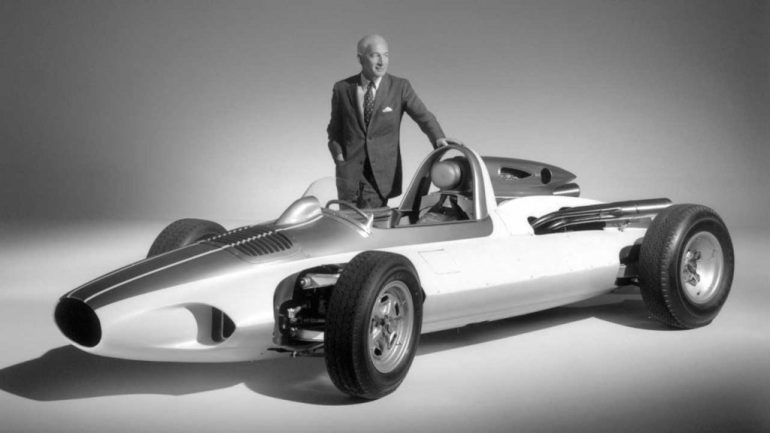 Zora Arkus-Duntov stands beside the CERV I, considered by many as the earliest mid-engine Corvette prototype. Duntov did not live to see the mid-engine Corvette become a reality, but his vision fueled its evolution for nearly sixty years!
Zora Arkus-Duntov stands beside the CERV I, considered by many as the earliest mid-engine Corvette prototype. Duntov did not live to see the mid-engine Corvette become a reality, but his vision fueled its evolution for nearly sixty years!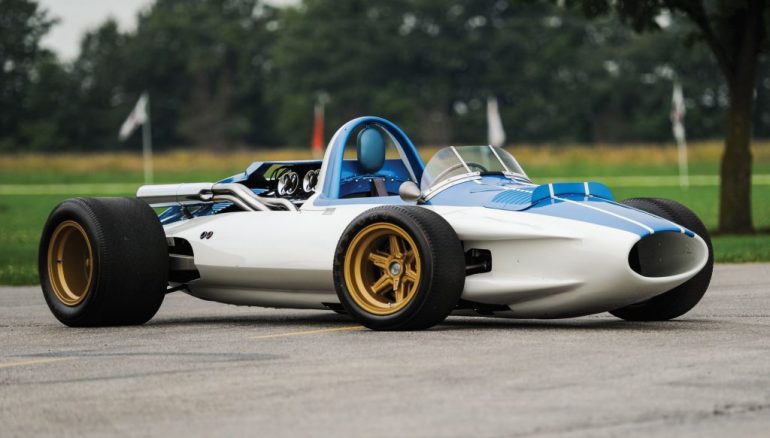 Developed by Zora Arkus-Duntov in 1959, the CERV I (which came into existence just six years after the Corvette) featured a mid-engine configuration and is generally considered the earliest predecessor of the Mid-Engine Corvette.
Developed by Zora Arkus-Duntov in 1959, the CERV I (which came into existence just six years after the Corvette) featured a mid-engine configuration and is generally considered the earliest predecessor of the Mid-Engine Corvette.
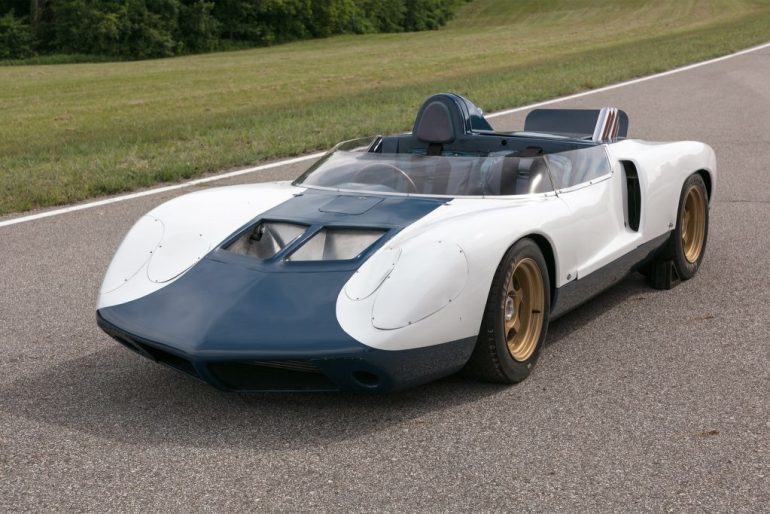 The CERV II, also developed by Duntov, begins to contain design elements synonymous with both the second and third-generation Corvettes.
The CERV II, also developed by Duntov, begins to contain design elements synonymous with both the second and third-generation Corvettes.
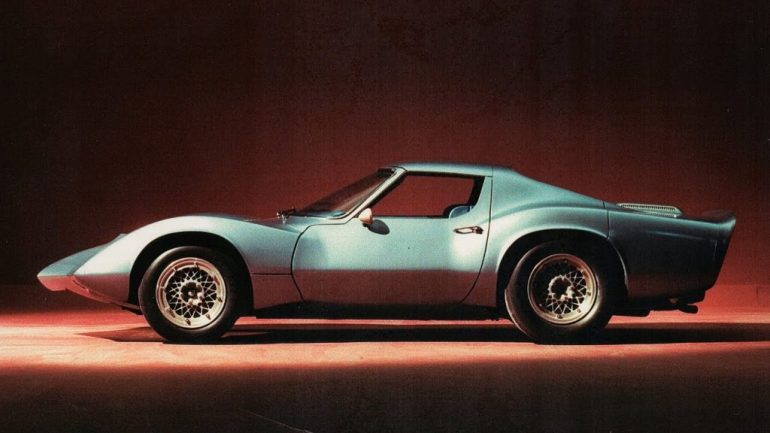 The XP-819 is considered by most Corvette enthusiasts as the first “official” mid-engine Corvette prototype, despite being rejected by GM upon its introduction in 1964.
The XP-819 is considered by most Corvette enthusiasts as the first “official” mid-engine Corvette prototype, despite being rejected by GM upon its introduction in 1964.
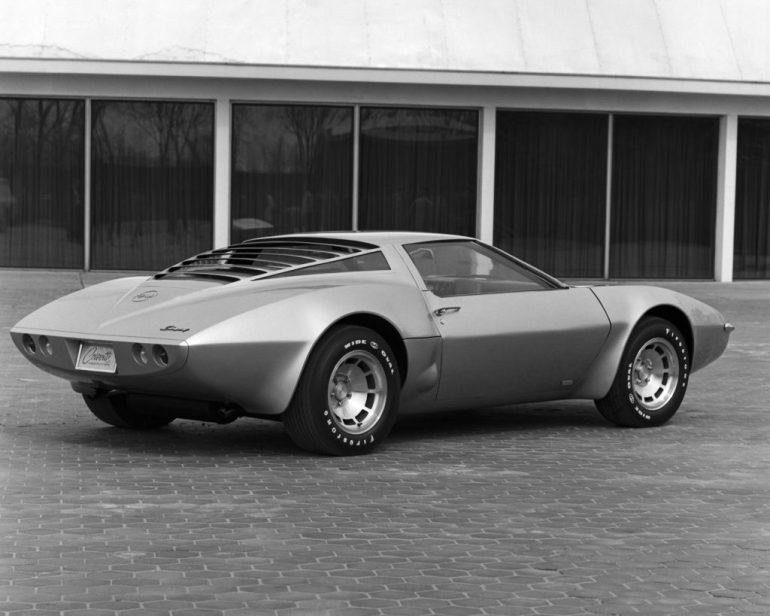 The 1970 XP-882. Here’s an interesting footnote about this car – during its development, one variant of the car featured gullwing doors. It has often been speculated that John DeLorean introduced that idea on the XP-882 and carried it with him when he started his own automobile company just a few years later.
The 1970 XP-882. Here’s an interesting footnote about this car – during its development, one variant of the car featured gullwing doors. It has often been speculated that John DeLorean introduced that idea on the XP-882 and carried it with him when he started his own automobile company just a few years later.
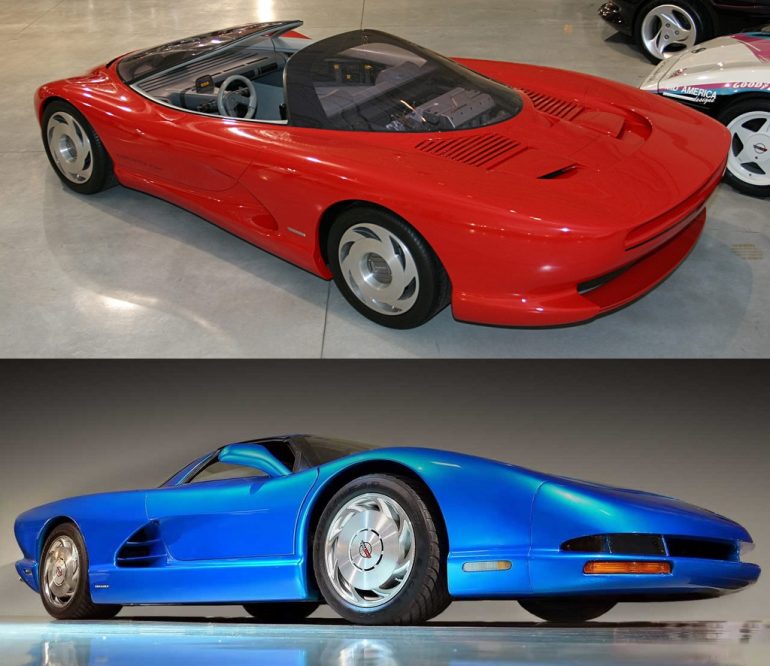 The 1986 “Corvette Indy” (top) and 1990 CERV III (bottom) were the prototypes for a fifth-generation Corvette, but once more cost cuts prevented a mid-engine production car from becoming a reality.
The 1986 “Corvette Indy” (top) and 1990 CERV III (bottom) were the prototypes for a fifth-generation Corvette, but once more cost cuts prevented a mid-engine production car from becoming a reality.
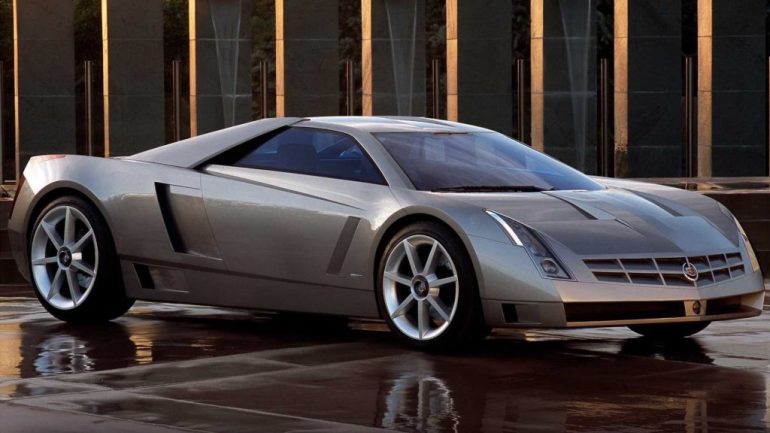 The 2002 Cadillac Cien featured a massive 7.5-liter, V12 engine rated at 750 horsepower.
The 2002 Cadillac Cien featured a massive 7.5-liter, V12 engine rated at 750 horsepower.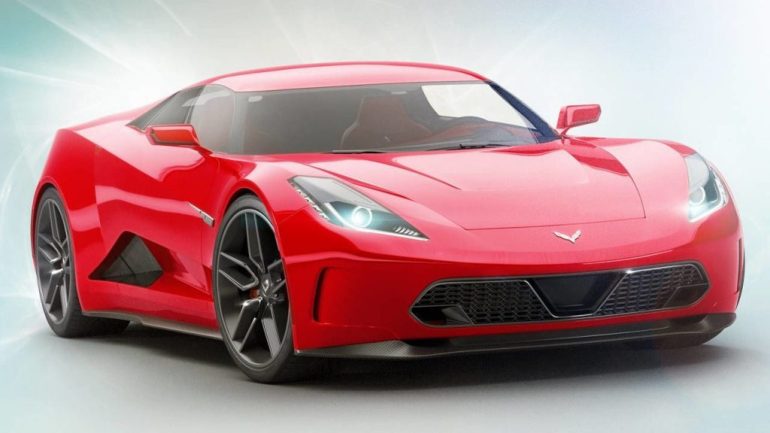 The Corvette “Zora” as rendered by Car and Driver Magazine.
The Corvette “Zora” as rendered by Car and Driver Magazine.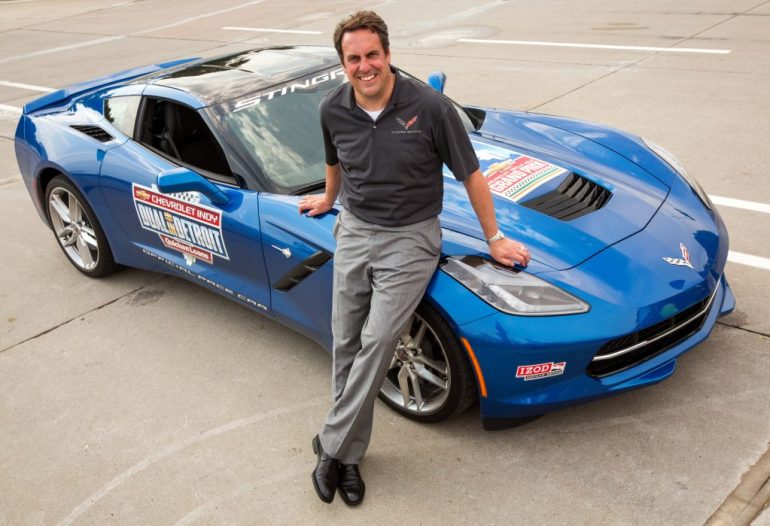 Mark Reuss, GM’s Head of Global Product Development at the 2014 Detroit Belle Isle Grand Prix.
Mark Reuss, GM’s Head of Global Product Development at the 2014 Detroit Belle Isle Grand Prix.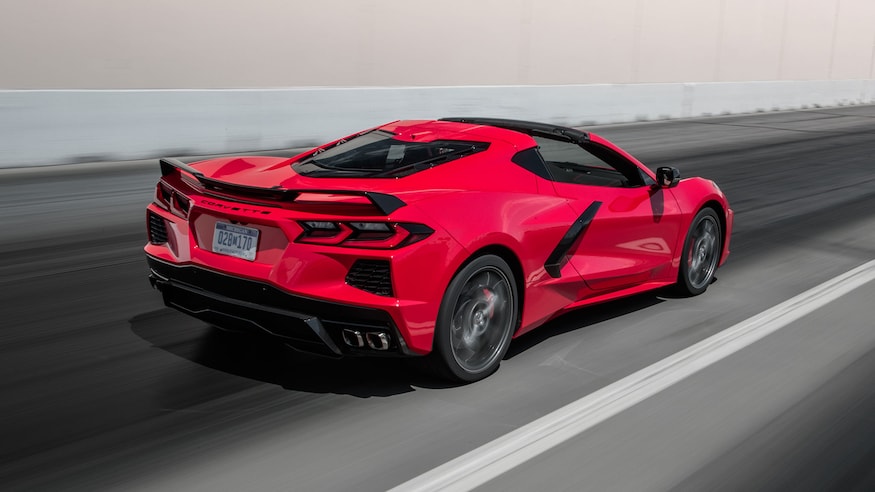
That was actually one thing we knew right from the beginning, is we weren’t going to be able to keep it a secret.
Tadge Juechter
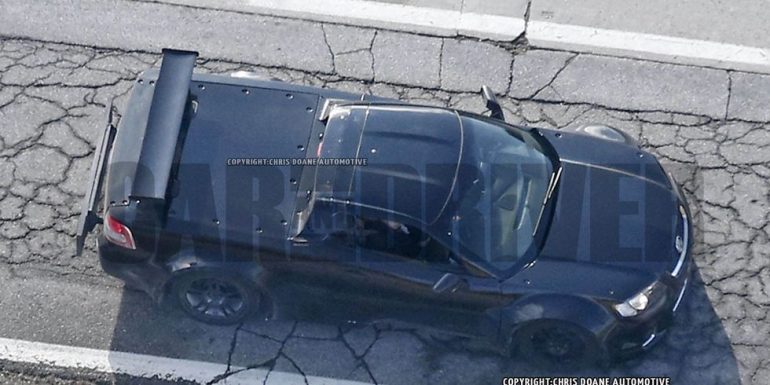 Exclusive spy photo of an early Mid-Engine Corvette engine test-mule as seen in Car & Driver in January, 2015.
Exclusive spy photo of an early Mid-Engine Corvette engine test-mule as seen in Car & Driver in January, 2015.
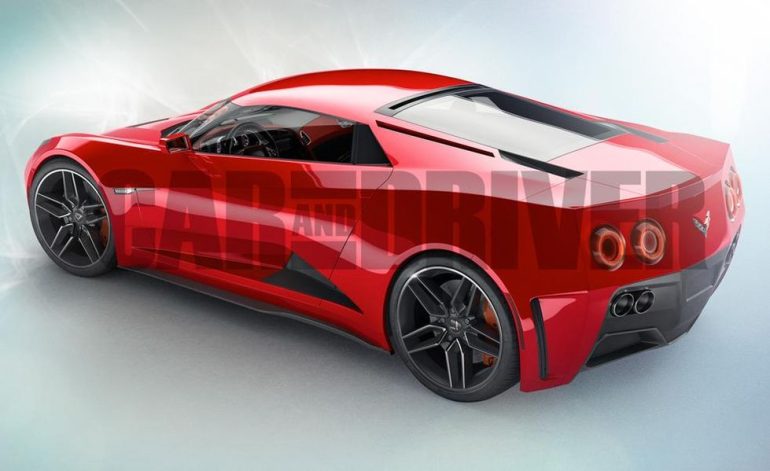 The Corvette Zora, which was believed to be a 2017MY vehicle, as rendered by Car and Driver for their 2014 article about the Mid-Engine Corvette.
The Corvette Zora, which was believed to be a 2017MY vehicle, as rendered by Car and Driver for their 2014 article about the Mid-Engine Corvette. Car and Driver Magazine spy photo of the future Mid-Engine Corvette taken in June, 2016.
Car and Driver Magazine spy photo of the future Mid-Engine Corvette taken in June, 2016.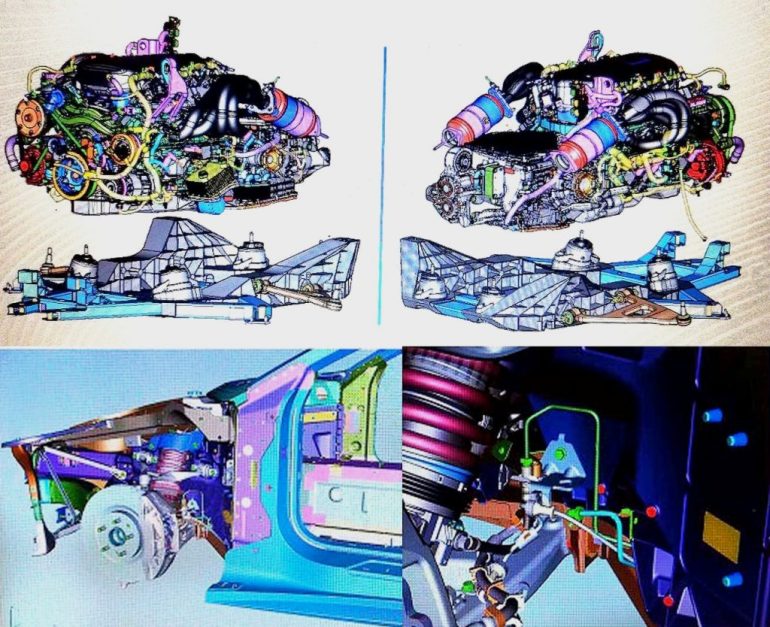 These CAD images, originally released by a user on CorvetteForum.com, became one of the most talked-about pieces of information “leaked onto the internet.
These CAD images, originally released by a user on CorvetteForum.com, became one of the most talked-about pieces of information “leaked onto the internet.
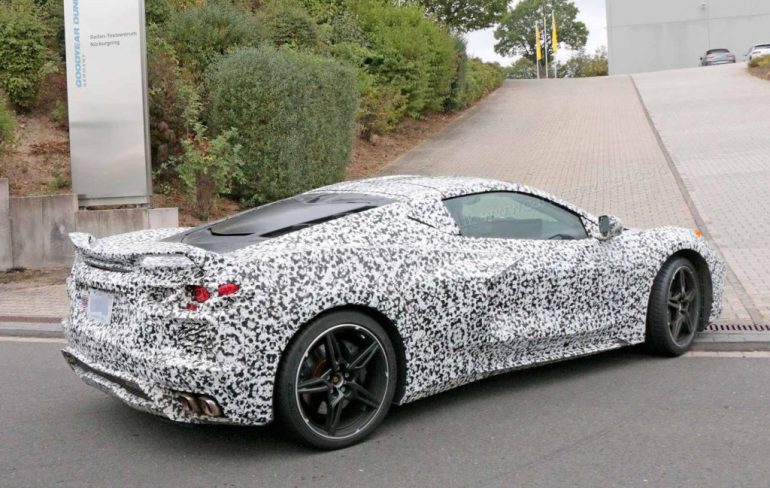 Spy photo of a C8 Corvette test-mule pulling into a GM testing center.
Spy photo of a C8 Corvette test-mule pulling into a GM testing center.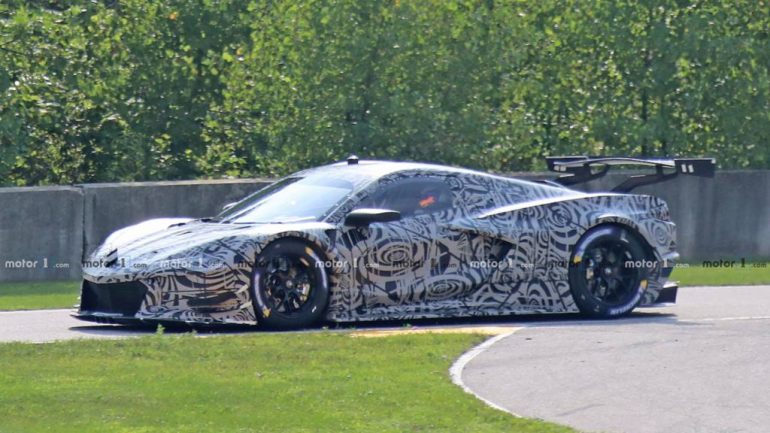 One of the earliest pictures of the C8.R Corvette Race Car. (Image courtesy of Motor1.com)
One of the earliest pictures of the C8.R Corvette Race Car. (Image courtesy of Motor1.com)
Leaked CAD Drawings Provide Big Clues
As an interesting side-note to the development of the mid-engine Corvette, there was a considerable amount of “leaked” material about the car that appeared on Corvette message boards and forums across the internet. Some speculated that the information was intentionally leaked by GM insiders to help build mystique around the car. Most of these “leaks” were spy photos and videos that were framed just a little too concisely or showed just a little too much up-close detail. However, one of the biggest leaks was a series of CAD drawings that showed elements of the car’s engine, transmission and suspension in exquisite detail.
On December 14, 2017, on the appropriately named CorvetteForum, an individual that went by the username “ZERV” posted a link to CAD images that almost definitely belonged to the mid-engine Corvette. The images included CAD renderings that appeared to show the car’s sub-structure and engine.
While some speculated that the CAD images were nothing more than an elaborate hoax by an individual trying to be “in the know” about the (then) future mid-engine Corvette, the degree of detail that had been put into each of these 3D renderings was far too elaborate to be a prank. The other, more commonly accepted idea was that the image “leak” was actually an intentional marketing tactic by General Motors to rouse interest in the mid-engine Corvette.
Within minutes of the images finding their way onto the world wide web, this story became one of the most talked-about automotive topics on the internet. Most of the major publications (including Corvsport.com – you can see our original article by clicking here) began re-publishing the images, offering whatever insight they could glean from each of the image files.
The images, which were almost instantly analyzed by serious (though covert) Corvette enthusiasts, provided some interesting details about many of the design elements of the car. This Corvette was going to feature coilover suspension, an engine that looked an awful lot like the LT1 (turned out to be the LT2 (more on that below)), magneto-rheological shocks (or shocks that allow the driver to control/alter the ride type of the vehicle, etc.) Additionally, elements of the various renders showed exterior elements of the car, such as sideskirts, that matched up identically with the spy photographs that had been published over the previous year.
As compelling as the photographs were, this was the first real look into the engineering behind the mid-engine Corvette – and it showed the world that Chevrolet was working towards something truly spectacular and unprecedented in the history of the brand. By late 2017/early 2018, Chevrolet had largely thrown caution to the wind and had begun openly driving their mid-engine Corvette in public. Excited spectators were quick to photograph the test-mules on their mobile devices and GoPro cameras, which afforded the world a flood of new images on a near daily basis. In a February, 2020 interview with GM Authority, Tadge Juechter, the Corvette’s chief engineer, responded with a laugh and the following comment when asked how the Corvette design team had planned to keep the car a secret during this time.
“That was actually one thing we knew right from the beginning, is we weren’t going to be able to keep it a secret,” Juechter said. He also confirmed the fact that his team utilized a Holden Ute as a test mule to make people “at least question what it was.”
The C8.R Corvette Race Car
Much like the combined evolution of the C7.R and the seventh-generation Z06 Corvette, the mid-engine C8 production car owes much of its DNA to the development of its race car counterpart. Chevrolet, working in cooperation with Pratt & Miller, began development of the mid-engine C8.R Corvette race car. The car, which was developed in parallel with the production vehicle, was developed to meet the homologation requirements of the IMSA sanctioned WeatherTech SportsCar Championship series.
On August 10, 2018, photographs of the new C8.R surfaced on the internet. These images, unlike the countless images of the production car, revealed a Corvette race car largely devoid of any heavy coverings that might have concealed its more elusive features. Although the car was still wrapped in the same black and white camouflage as that of the production model, the race car gave spectators an otherwise unmasked look at the profile of the new Corvette. Admittedly the C8.R, like all of its predecessors, has a different stance and a number of distinct bodylines that are unique to the race car, the newer race cars (the C7.R and C8.R) are so closely related to their production counterparts that they share a number of the same components.
Before long, video footage of the C8.R surfaced (see below), and with it, our first opportunity to listen to the new race engine. The exhaust note of the mid-engine C8.R Corvette was distinctly different from any of its predecessors. This led many to speculate that the C8.R might actually utilize a V6 engine as its powerplant. Given that Ford had done so by introducing an EcoBoost engine in their latest iteration of the Ford GT, the idea seemed plausible. However, as with so many of the other speculative changes that had been discussed during the investigative years of the mid-engine Corvette’s development, the idea of a six-cylinder Corvette race car caused an outcry of disappointment from anxious fans eager to see Corvette continue to dominate at the track. Further, there was a great deal of debate as to whether or not the production model might also feature a six-cylinder engine.
They needn’t have worried…
July 18, 2019 – The Dream Becomes Reality
For more than half a century, Zora Arkus-Duntov had dreamed of a mid-engine Corvette. On July 18, 2019, that dream officially became a reality. The official unveiling by General Motors happened from a specially customized hangar in Orange County, California. While access to this event was by invitation only, and while tickets for this event were incredibly difficult to come by, GM provided the world with a real-time live stream, where enthusiasts around the globe could watch this momentous occasion from the comfort of their own homes. The stream featured a number of unique videos showcasing earlier generations of the Corvette and a hosted pre-show.
“There is a large contingent of Corvette fans across the world waiting for the reveal of the Next Generation. We’re happy to give these fans, and all sports car enthusiasts, a way to see and learn about the vehicle at the same time as those participating live in California,” said Barry Engle, executive vice president and president, the Americas, GM. “Viewers will hear directly from Chevrolet leadership, engineering and some special guests about the highlights and background of this first mid-engine Corvette.”
The official reveal began with retired astronauts Dr. Mae Jemison and Scott Kelly presenting on the main stage with video of the Apollo 11 moon-landing mission, and with General Motors executive vice president Barry Engle talking about how many Mercury and Apollo astronauts owned Corvettes. Then, as the excitement within the venue reached a climax, the all-new 2020 Mid-Engine Corvette was driven out onto the stage. The car, which had been the dream of so many for so long, did not disappoint! The rest of the event featured keynote speakers including Mark Reuss, Tadge Juechter, Mary Barra, Tom Peters and others...but the star of the evening was the car itself!
The response from the audience was thunderous applause! Beyond the people lucky enough to be at the unveiling in person, the live stream reached millions around the globe and generated an unprecedented amount of positive chatter on automotive blogs, forums and social media all around the globe.
After nearly sixty years of dreaming – the Mid-Engine Corvette, was finally a reality!
The C8 Mid-Engine Corvette
Almost everything that follows below in this section comes from the official press releases by GM (and other major trade publications) about the 2020 Mid-Engine Corvette. Just the same, it is important to understand that many elements developed during the evolution of the Corvette were based on the nearly endless input and feedback from the global Corvette community. As evidenced in all of the examples above (as well as the countless others that were not documented here solely in the interest of keeping this overview to a reasonable length), the designers and engineers at GM took the feedback they received from every rendering and every leaked photograph and made considerations to incorporate elements from that data into the final design of the 2020 Mid-Engine Corvette.
A Design Inspired By Racing and Aeronautics
“Corvette has always represented the pinnacle of innovation and boundary-pushing at GM. The traditional front-engine vehicle reached its limits of performance, necessitating the new layout,” said GM President Mark Reuss. “In terms of comfort and fun, it still looks and feels like a Corvette, but drives better than any vehicle in Corvette history. Customers are going to be thrilled with our focus on details and performance across the board.”
As the Corvette engineers set to work on the revolutionary re-design of the Chevy Corvette for the 2020 Mid-Engine model, it was made abundantly clear to all involved that the car would need to incorporate a “bold, futuristic expression with mid-engine exotic proportions” but it sill had to be unmistakably recognizable as a Corvette.
To accomplish this not-inconsiderable task, the designers of the C8 Corvette, led by Tom Peters, Director of Design for the GM Performance Car Studio and Kirk Bennion, Corvette Exterior Design Manager found inspiration from past iterations of the Corvette as well as military aircraft and Ducatti motorcycles! While there are countless examples of this throughout the design, there are a couple of significant design elements of note that are worth documenting here.
The C8 Corvette Stingray was designed to include a canopy-forward stance that was inspired the F-22 Raptor and the F-35 Lightning II. The design resulted in the car’s cockpit being migrated forward nearly 16.5 inches from its seventh-generation counterparts. The cockpit design envelops the driver in a way that feels very much like sitting in the cockpit of a fighter jet.
When it came to the engine placement, Tom Peters was passionate about showcasing the engine as part of the car’s overall aesthetic design. In fact, he felt that the new V8 engine would be the “jewel” of the design, with the rest of the Corvette itself serving as the backdrop for this important design element. According to Jordan Lee, GM‘s chief engineer of small-block engines, Peter’s summoned the LT2 engine team into his studio, where he introduced them all to images of exotic cars’ engine bays. More than that, a pair of Ducati Panigale models — an 899 and a 959 — were brought into the studio at different points in the design process.
“Engine beautification and under-hood beautification became a priority on this vehicle because it is unique,” said Paul Arnone, senior creative designer (in an interview with Roadshow.) “It’s our first big, mid-engined Corvette coming out, and it was very important to General Motors. We just wanted every part of this vehicle to look designed.”
“We wanted to approach this from the aspect where we weren’t covering our sins by putting a big, honking plastic cover over our engine, we wanted to scale back on the plastic and show more of the engine,” said Guy Samuels, creative designer. “Our leadership referred to it [the LT2] as an ‘honest design’ so from a benchmark standpoint, we used Ducati motorcycles. Motorcycles are as honest as you can possibly get when you talk about mechanicals.”
Naturally, the design team of the mid-engine Corvette recognized the importance of incorporating design elements into the C8 that represented the history and heritage of the generations that came before it. Many classic Corvette signatures were adapted into the new mid-engine Stingray’s design. As aggressive as the new Corvette’s stance was, and as much of a departure as this design was from the generations that preceded it, the C8 Corvette includes a distinctive front fascia that communicates the purpose of the vehicle’s mission, a classic horizontal crease, aggressive front fenders and familiar positioning of the dual-element headlamps.
“As America’s most iconic performance nameplate, redesigning the Corvette Stingray from the ground up presented the team a historic opportunity, something Chevrolet designers have desired for over 60 years,” said Michael Simcoe, vice president of Global Design, General Motors. “It is now the best of America, a new arrival in the mid-engine sports car class. We know Corvette can stand tall with the best the world has to offer.”
Form Follows Function
The statement “form follows function” has been one of the primary focuses of Corvette since the development of the seventh-generation Corvette. While the aesthetics of the C8 Corvette has always played a huge role in maintaining the iconic “look” of the brand, the design and engineering teams of the seventh and eighth-generation Corvettes has been intentional about making sure each surface, intake, curve, crease and angle also helps enhance the car’s driveability.
The new location of the C8’s engine was the focal point of the entire car’s design. From an engineering standpoint, focusing on a mid-engine placement of the engine resulted in many functional considerations to be incorporated into the design, including:
Better weight distribution, with the rear weight bias enhancing performance in a straight line and on the track.
Better responsiveness and sense of control as a result of placing the driver’s position closer to the front axle, almost on top of the front wheels.
The fastest 0-60 time of any entry-level Corvette ever — under three seconds when equipped with the Z51 Performance Package.
A race car-like view of the road as a direct result of the lower positioning of the hood, instrument panel and steering wheel. Excellent forward sightlines throughout the vehicle for both the driver and passenger.
An enhancement of Corvette’s traditional utility strengths, with dual trunks for a total of 12.6 cubic feet of cargo volume, ideal for the storage of luggage or two sets of golf clubs.
As Tadge Juechter, Corvette’s lead engineer and his team began the process of incorporating all of these design elements into a production vehicle that could provide both on-and-off the track versatility, they looked to the Corvette’s European counterparts for inspiration. In an interview first published in July, 2019 by Road and Track magazine, it was identified that the engineering group behind the mid-engine Corvette started their process by driving and benchmarking a number of European sports cars, starting with the Porsche 911 Turbo S.
“We even had a McLaren for a little while,” said Juechter. “We had a Ferrari 458 that we thought was closest in the overall package. The size, the dimensions of the car, V-8, you know. It has some of the same challenges. So we did a lot of benchmarking around the 458, which a lot of people say is the best sports car ever created.”
Taking the information that was gleaned from studying each of these mid-engine cars, Juechter and team began to identify the elements from each car that was most critical to its function. In most (if not all) examples, the design elements most critical (in addition to engine placement), was structural rigidity and balanced suspension.
As such, the new Corvette’s structure is built around its backbone: the center tunnel. This layout enables a light, stiff structure that serves as the foundation of the car’s suspension system. By removing unwanted body compliance, Corvette’s engineers were able to enhance the car’s suspension, resulting in a ride performance that produces outstanding lateral grip capabilities. The new Corvette has a solid, connected-to-the-road feel with minimal vibration throughout the powerband – even at high speeds.
Additionally, the tunnel-dominant design approach offers a number of other advantages, including:
Improved torsional rigidity with a solid, connected feel on both the road and track.
Outstanding ingress/egress for a mid-engine vehicle. Unlike some competitors, there’s no need for oversized rocker panels to bear structural and load weights, making it easier to enter and exit the vehicle.
Excellent stability due to a low center of gravity and outstanding handling.
Preservation of Corvette’s beloved standard removable roof panel, which can easily be stored in the rear trunk.
A front storage compartment that can fit an airline-spec carry-on and a laptop bag.
Availability in both left- and right-hand-drive variants — a first for Corvette.
Smart packaging with improved cabin comfort, including an additional inch of rearward seat travel and almost double the reclining angle.
“Our mission was to develop a new type of sports car, combining the successful attributes of Corvette with the performance and driving experience of mid-engine supercars,” said Tadge Juechter,
Juechter has also spoken openly about the relationship the development team had with the Corvette Racing program. He has stated that the race team helped his team a great deal by assisting with thermal modeling, vehicle dynamics, and weight distribution. Juechter also said that that the race-spec C8.R was developed in parallel to the street car in order to make it as competitive as possible come race day.
“We’re super close to the race team,” Juechter said (in an interview with GM Authority). “We have joint meetings all the time, talking about various aspects on the vehicle design. It’s almost like one team at this point.”
The result of these studies, and the incorporation of elements developed in cooperation with the Corvette Racing program, extensive wind-tunnel testing and years of conceptual study and design resulted in an all-new Corvette Stingray that features a a “smart mixed-materials strategy,” resulting in a number of key design features, including:
A strong, stiff and lightweight main structure of six high-pressure diecast aluminum parts, also known as the “Bedford Six,” which are manufactured at GM Powertrain in Bedford, Indiana. These minimize the number of joints within the vehicle, making a stiffer structure that aids in handling and track cornering.
An industry-first carbon fiber curved rear bumper beam for weight reduction.
Front and rear trunk tubs and dashboard molded from ultra-lightweight “float” derived from fiberglass and a proprietary resin. The material is so light that it can actually float in water. It works with other fiberglass and carbon fiber variants to lower mass and reduce noise and vibration.
At the Heart of the Beast
The Engine
As stated previously, a lot of consideration was made on how best to incorporate elements of the Corvette from generations past into the mid-engine Corvette platform. While the C8 Corvette was going to be a complete departure from the cars that came before it, the evolution of Corvette’s engine program from the mid-1990’s on has given birth to some of the most powerful and durable small-block engines in the history of Chevrolet. As such, a lot of consideration was given to incorporating those “lessons learned” when selecting/developing the powerplant for the next-generation Corvette.
It was with these considerations in-mind that the design team elected to develop a next-generation 6.2 liter, small-block V8 engine for the base model mid-engine Corvette. Dubbed the LT2, it is unique in that it is the only naturally aspirated V8 engine in its segment. The engine, which is rated at an impressive 495 horsepower (369 kW) and 470 lb-ft (637) Nm) of torque (when equipped with performance exhaust), is the most powerful engine ever introduced in an entry-level Corvette.
“Though now placed behind the driver, the LT2 gives the same visceral experience we all expect from Corvette,” said Jordan Lee, GM’s global chief engineer of Small Block engines. “The LT2 has been designed to deliver excellent low-end torque and high-end power to give thrilling pedal response at any RPM.”
The low placement of the powertrain in the mid-engine Corvette results in a low center of gravity for the entire car, which is optimal for optimal handling. While the engine incorporates many elements of its predecessors, its biggest update is found in its lubrication and ventilation systems. For the first time in Corvette’s history, the base-model will utilize an engine-mounted dry sump oil system and three scavenge pumps for improved track performance. The benefit? During serious track driving the dry sump system will ensure oil volume remains high to avoid diminished performance. Just as the Stingray’s lateral capability has been dramatically improved, the LT2’s dry sump lubrication system had to be designed to provide exceptional engine performance – even at lateral acceleration levels exceeding 1G in all directions.
To help showcase the new LT2 engine, the design team incorporated a lightweight, 3.2mm-thich glass panel on the Corvette’s rear hatch with enables owners to show off the engine. It was decided early on that the engine would become part of the car’s outward aesthetics (much like the powerplants seen in both the sixth– and seventh-generation ZR1 models). Because the engine is now part of the car’s outward (exposed) design, GM engineers and designers worked together to make this major element an integral part of the car. The result is a “jewel-like” housing in the rear compartment which is visible thru the rear glass hatch. Every part of the engine, including the engine’s wiring, tubes, routing fasteneres, coolant hoses, exhaust manifolds, etc.,were all developed with appearance in mind. Even the engine’s heat shields are textured.
The Transmission
As though the LT2 engine wasn’t impressive enough on its own merits, Chevrolet has paired the LT2 with their first-ever, eight-speed, dual-clutch transmission. The transmission, which wad designed and developed in cooperation with the TREMEC transmission corporation, provides lightning-fast shifting and excellent power transfer from the engine to the rear axle.
Early in the C8’s development, it was decided that a manual transmission would no longer be offered as an option to consumers. There were several considerations that went into making this decision. First, while there are still those enthusiasts who believe a sports car should be equipped with a manual transmission, the sales numbers of the sixth- and seventh-generation Corvettes proved over and over that interest in a manual transmission had steadily declined from 2005 on. However, this was only part of the reason the “automatic only” decision was made. In an interview with Car and Driver Magazine, Tadge Juechter stated that a large part of the reason to eliminate the manual transmission option from the design was the engineering team’s desire to avoid breaching the mid-engine C8’s central tunnel.
“That tunnel is the backbone of the car, and if you break the backbone, you lose a lot of structural efficiency,” explained Juechter. “With a shifter, you have to have a big hole in the tunnel for the linkage to go through.”
The reality is that the new eight-speed automatic transmission provides the best of both worlds: the directly connected feeling of driving a manual thanks to the inclusion of paddle shifters, which includes a double-paddle de-clutch feature which allows the driver to disconnect the clutch by holding both paddles for additional manual control, and the premium experience of driving an automatic. The truth is, this new 8-speed automatic produces dramatically increased performance over any automatic that came before it in the history of the Corvette brand. The launch control functionality and quicker shifts easily outperform that of any manual-equipped car.
“The performance shift algorithms are so driver-focused, they can sense when you’re doing spirited driving — regardless of driving mode — and will hold lower gears longer for more throttle response,” said Juechter.
The new LT2 V8 engine has a torque curve optimized to take advantage of the custom-engineered dual-clutch transmission’s lightning-fast shifts. Engineers set the transmission up with a very low first gear to leverage the additional traction needed to get the car off the line quickly, and used its close-ratio gears 2 through 6 to keep the engine near the power peak on track. Tall seventh and eighth gears make for easy long-distance cruising with low mechanical stress and excellent fuel economy.
Handling and Drivability
While power and performance are paramount to any Corvette owner, the engineering that went into the C8 Corvette Stingray also took ride comfort into more serious consideration. It was important that the new Corvette ride comfortably on the open road while being equally capable of handling the rigors of driving on a racetrack.
“Thanks to sophisticated suspension geometry, tailored tire technology and exquisite attention to structural details, we have improved ride and handling,” said Juechter. “No Corvette has ever felt so comfortable, nimble and yet completely stable.”
The core of this balance between comfort and performance starts with the use of the standard premium suspension package (RPO FE1) which features coil over dampers. Where earlier iterations of the Corvette relied on conventional shock absorbers with a leaf-spring assembly, the C8 incorporates coil-over struts at all four axles to introduce entirely new ride and handling characteristics unique to the Mid-Engine Corvette. The reduced unsprung weight of the suspension along with the introduction of Short/Long Arm (SLA) front and rear suspension (also known as double-wishbone suspension), will vastly improve the Corvette’s handling.
One important addition to the Mid-Engine Corvette’s suspension system is its ability to raise the car’s ground clearance by approximately 15 inches at the front bumper in just 2.8 seconds. Given the Corvette’s known history of front-end impacts with curbs, speedbumps and other road disturbances, the introduction of this new feature to the suspension system will work automatically to raise the car’s front end to avoid these types of impacts. The system operates via an internal GPS, can operate at speeds up to 24 miles-per-hour and will remember up to 1,000 operator-saved locations.
Moving to the steering system, the mid-engine architecture allows for short, straight and stiff steering that is coupled with an updated electronic power assist that makes the driver’s chassis input instantaneous. Steering is controlled by the driver via a newly-designed steering wheel. This new steering wheel features a “square” design which Chevrolet claims improves visibility and provides for greater comfort. The steering wheel is mounted atop a new, rake-adjustable steering column that was also developed to improve driving comfort by being adjustable for operators of varying size. The steering ratio has been improved in the C8 Corvette from 16.25:1 to 15.7:1.
The C8 Corvette’s stopping power comes from factory-installed Brembo Brakes. This is a standard feature on all versions of the Mid-Engine Corvette coupe. The Brembo-supplied brake calipers are available to consumers in one of four colors: Edge Red, Black, Yellow or Bright Red. Additionally, the Brembo Brakes will include all-new zero-copper NonAsbestos-Organic (NAO) brakes pads designed to meet current environmental regulations. While these NAO brake pads are environmentally friendly, they will also provide excellent stopping power.
As with other-generations of Corvette before it, the C8 will once more feature the Z51 performance package as an available option to all consumers. This package includes a number of goodies that will enhance the drivability of the mid-engine Corvette, including:
Performance Suspension (FE3)
Larger, Brembo Brakes that feature a Z51 graphic (J55)
Electronic-limited slip differential (eLSD)
Dual Mode Exhaust (NPP)
A Front Splitter
A Rear Fascia-mounted Spoiler
Additional cooling provisions
And adjusted rear axle ratio
Of course, Magnetic Selective Ride Control will be included on models equipped with the Z51 Performance package. This latest iteration – Magnetic Ride Control 4.0 – reads the road better, provides more precise data through suspension-mounted accelerometers. Its improved electronics respond faster and more smoothly to driver inputs and contributes to the car’s overall ride quality.
Exterior
While it has already been stated that the “jewel” of the mid-engine Corvette is its engine, a great deal of work went into the rest of the car’s exterior design to maximize the aesthetic while adhering to the mantra “form follows function.” The results speak for themselves.
The C8 Corvette Stingray features low profile headlamps that were designed around all-new projectors. These headlamp assemblies fit seamlessly in the car’s aggressively sculpted front fenders. Following the car’s lines back along the fender and to the driver and passenger doors, it is worth noting that the releases for the door (as well as the hood and hatch releases) are completely concealed and do not disrupt the continuity of the car’s lines. While it was necessary to incorporate large air-intakes into the rear quarter panel assemblies to feed the LT2 engine, the design team at Corvette molded the placement of the intakes into the natural progression of the car, creating intakes that look like the air intakes of a fighter jet (perhaps an intentional nod to the F-22 Raptor upon which some of the design was inspired.) Wrapping around the rear of the car, quad exhaust tips adorn the vehicle’s outboard end while dual-element LED taillamps (with animated turn signals) frame the rear fascia nicely.
Once more back at the front of the car, a front splitter helps generate downforce for improved grip during aggressive driving conditions, especially while cornering. Moving up and over the car, the short nose and front bonnet cover a “frunk” (front trunk) that can easily accommodate a small carry-on suitcase and a computer bag. Beyond the front hood, the car’s aggressively swept A-pillars convey speed while assisting in visibility. The removable top, a staple on the Corvette since 1984 (and even longer if you include those models that were built with T-top assemblies), either sits locked in place, thereby continuing the lines of the hood up-and-over the “shoulders and spine” of the car, or else rests stowed in the rear trunk, where it locks neatly away for those days when open-air driving is the desire of the car’s owner. Past the removable top is the large, rear hatch which showcases the engine. The hatch, an integral part of the car’s aesthetic design, also features seven separate air vents to allow engine cooling during any driving condition. Finally, a two-piece rear spoiler adds to the collective 400 pounds of downforce generated by it and the front splitter.
Consumers looking to purchase a mid-engine Corvette have a number of exterior (and interior) options that they can select from to make the car uniquely their own. For starters, there are a total twelve exterior colors you can choose from, including: Torch Red, Arctic White, Black, Blade Silver Metallic, Shadow Gray, Ceramic Matrix Gray, Long Beach Red, Elkhart Lake Blue and Sebring Orange — plus three all-new colors: Rapid Blue, Zeus Bronze and Accelerate Yellow. In addition to paint color, there are five unique wheel choices available.
Regardless the wheel selection, all of the new C8 Corvette wheels come wrapped in Michelin’s all-season performance tires. These tires were designed with performance in mind and are the first sports car application of the Michelin all-season tires. They can handle cornering at nearly 1G!
Interior
While the customization of the exterior allows consumers the opportunity to select the car’s color, wheel choices, and some various trim options, the interior of the C8 Mid-Engine Corvette is one of the most customizable in the history of the brand. From seat belts to the seats themselves, there are dozens of unique configurations that can be selected while customizing the interior. From fabric choices to the color of the seatbelts and interior stitching, there are a lot of options to consider here.
For starters, there are three seat options available: GT1, GT2 and Competition Sport. The GT1 seats feature a classically sporty style, but are more comfort-oriented. These seats feature Mulan leather trim, optional two-way lumbar support and wing adjustment. The GT2 seats are race-inspired and were designed for both moderate track handling as well as taking long road trips comfortably. They include carbon fiber trim, a Napa leather insert, Mulan leather bolsters, a jet black-painted seat back, two-way lumbar support and wing adjustment, plus heating and ventilation. Lastly, the Competition Seats is the sportiest option of the three. It features additional, aggressive bolstering on the sides and carbon-fiber trim on the headrest. They come finished in full Napa seating surfaces and carbon fiber trim on the headrest, heating and ventilation, along with an all-new durable performance textile inspired by Kevlar vests.
Beyond the high-quality finishes offered on each of the various seat options, the entire cockpit is appointed with high quality craftsmanship and materials. All of the leather elements in the cockpit are hand-wrapped and sewn together with thick press stitching. The Bose speakers feature stainless steel speaker grilles and either carbon fiber or genuine aluminum trim components are offered for both the center console and the door trim plates.
While the seats may have the greatest impact on the actual driveabilty of the car, the eighth-generation Stingray provides an all-new digital vehicle platform which utilizes an electronic architecture that enables the car to incorporate Chevrolet’s next-generation technology packages. This architecture minimizes the amount of wiring needed within the internal infrastructure of the car, which allows for faster signal transmission between different vehicle systems and across all of the car’s high-resolution screens (from the dashboard to the car’s infotainment center.) These cars are packaged with more technology than any Corvette that came before it. The instrument cluster in the center of the driver’s dashboard can be customized to provide custom feedback in any of the car’s six-driver modes.
And speaking of driving modes, the new C8 Corvette ups the ante from the seventh-generation Stingray by introducing a total of six different driving modes, including:
Weather: When the weather turns rough, choose this mode for optimal traction. It distributes appropriate power to the rear wheels. The vehicle’s sensors can also adjust the traction control and throttle progression to give you confidence when driving in slippery conditions.
Tour: This is the Corvette’s default mode. Automatic systems and sensor work to maximize comfort and dampen shocks. You can customize the gauge cluster to show audio, navigation, and phone information.
Sport: Maximizes responsiveness and power. This mode also stiffens Magnetic Ride Damping and lets you hear more of the throttle. The dashboard will display RPMs.
Track: Designed exclusively for track driving, this mode provides excellent off-the-line acceleration. It also tweaks Magnetic Ride Damping and steering effort to maximize responsiveness, while enabling Performance Traction Management and throttle progression. Your dashboard will show shift lights.
MyMode: a configurable setting for the driver’s individually preferred driving style. Once configured, the settings remains in the car’s memory even after complete ignition cycles.
Z-Mode: Named after the famed Z06, ZR1 and Z51 Corvette performance packages, is activated through a “Z” button on the steering wheel. This is a single-use mode that takes MyMode configurations one step further, allowing drivers to adjust the engine and transmission as well.
For both the driver and the passenger, the C8 Corvette features an array of creature comforts including a faster, simpler next-generation infotainment system with a higher resolution display, wireless charging for smart phones and other personal electronic devices, learn-as-you-go voice recognition, improved real time traffic as part of the integrated GPS and Chevy’s first-ever one-touch Bluetooth pairing with Near Field Communication. Near Field Communication (NFC) is a short-range wireless connectivity standard (Ecma-340, ISO/IEC 18092) that uses magnetic field induction to enable communication between devices when they’re touched together, or brought within a few centimeters of each other.
In addition to the bundled technology, the C8 Mid-Engine Corvette features a number of other electrical features that greatly enhance the driving experience, including:
Driver and passenger memory seats.
A heated steering wheel.
Tire-Fill Alert – a sensor which warns the driver when tire meets maximum pressure.
Two new Bose audio systems: a 10-speaker standard premium system and available 14-speaker Bose Performance Series system. Speaker grilles are integrated into lower door trim for a refined look that also helps guard against damage from footwear.
The industry-pioneering Performance Data Recorder – an advanced driving analysis tool upgraded with a high-definition resolution camera and a new, in-vehicle user interface. Customers can record both circuit and point-to-point road courses. The PDR can be set to auto-record like a dash cam that starts recording every time the Corvette is running or it can be configured to start only when the car is set to Valet mode.
The layout of the C8 Stingray’s cockpit provides both driver and passenger with ease of access to the technology built into the car. As stated earlier, the cockpit has been migrated forward by 16.5 inches. It now envelops the driver in a high-tech cockpit that conveys high performance and an aeronautical theme. All of the climate controls have been arranged along the narrow center console rail, reducing the amount of real estate they occupy on the dashboard. Similarly, the air vents are ultra-thin, reducing the overall height of the instrument panel, which adds to the open feel of the space.
But one of the elements that makes the interior of the eighth-generation Corvette most appealing is the amount of customization that is available to consumers who elect to build their own Corvettes. Customers can literally make their own design statement by creating a Corvette that is as unique as their individual tastes and personality. For starters, there are six interior color themes to consider: Jet Black, Sky Cool Gray, Adrenaline Red, Natural/Natural Dipped, Two-Tone Blue and Morello Red. There are six seat belt color options: Black, Blue, Natural, Torch Red, Yellow and Orange. There are also two optional stitching package: Yellow and Red, although cars finished with standard black interiors have Sky Cool Gray stitching.
As if these combination of colors weren’t enough to whet the appetite, Chevrolet has elected not to limit the color combinations for the 2020 model year. As a result, future Corvette owners can elect to have orange or yellow seatbelts installed as part of the two-tone blue interior.
Affordability and Acceptance
At the time of this article’s publication, manufacturing of the 2020 Mid-Engine Corvette had been suspended by Chevrolet as part of the global COVID-19 pandemic that had impacted our entire planet. As a result of this, and because of the increased demand by consumers to purchase the new Corvette, it is difficult to know exactly what the future of the brand looks like from a pricing standpoint. Corvette has always represented iconic American design, power, performance, technical ingenuity and attainability. When first introduced to the world on July 18, 2019, it was announced by Mark Reuss that the new mid-engine Corvette would have a base price of less than $60,000.00. To date, GM has honored that pricing, though that price covered only a “bare-bones” base model. Even with modest optional upgrades, the price of these cars climbed quickly to the $80,000 range and beyond.
Now, with the shortage of available mid-engine Corvettes on the open market combined with an increasing demand by would-be consumers looking to purchase one despite the constraints placed on production, time along will tell what impact this will have on the pricing of future iterations of the mid-engine Corvette.
As for how the car has been received so far? Ask any group of enthusiasts and you’ll get widely varying opinions about the mid-engine Corvette. While it’s been called “the worst Corvette ever,” by some, there are a great many more who love the potential of what this Corvette represents for the brand and its future on the global market. One individual, who goes by the username “LSX.Hub” on Instagram, had this to say about the car:
“Chevy just changed the game forever. This Corvette is going to be such an AMAZING value around $60,000. The 6.2 liter NA V8 (LT2) gives it 495 horsepower and 470 lb/ft of torque, bringing it from 0-60 mph in UNDER 3 SECONDS! Paired with an 8 Speed Tremec Dual-Clutch, this thing will be an animal. Leave your thoughts on it below! This car is officially a $60,000 supercar!”
Time alone will tell how this car either gains or loses popularity among Corvette purists. This much is certain however – unlike earlier-generations of the Corvette, whose primary demographic seemed to be middle-aged men on the wrong side of fifty, the new C8 Covette has evoked an interest in the brand that has been absent for decades. People of all ages are enticed by the aggressive stance of this car. Add to it that the car has the same mid-engine configuration as some of the hottest cars coming out of Europe at a fraction of the price, and the Mid-Engine Corvette can’t help but gain attention.
This much is certain – the arrival of the mid-engine C8 Corvette in 2020 has transformed one man’s vision of “what could be possible” for the Corvette of tomorrow into the “what is possible” for the Corvette of today….and we think – we BELIEVE – that Zora would be proud!
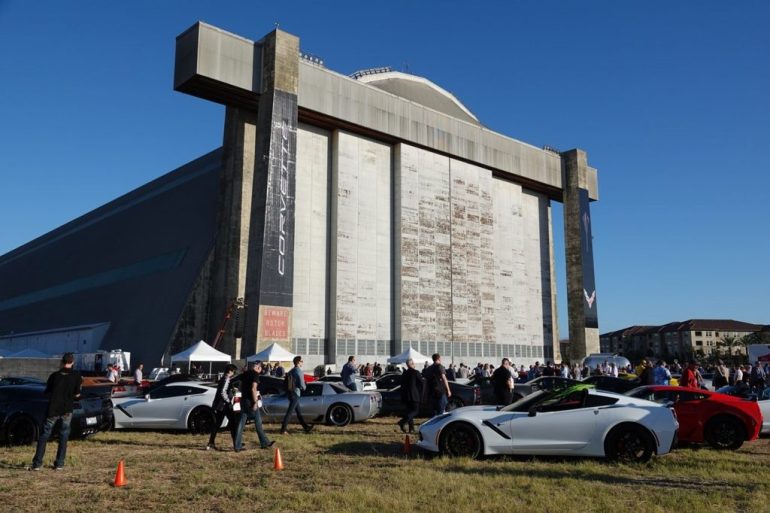 The Mid-Engine Corvette reveal took place inside a re-purposed hangar in Orange County, California.
The Mid-Engine Corvette reveal took place inside a re-purposed hangar in Orange County, California.

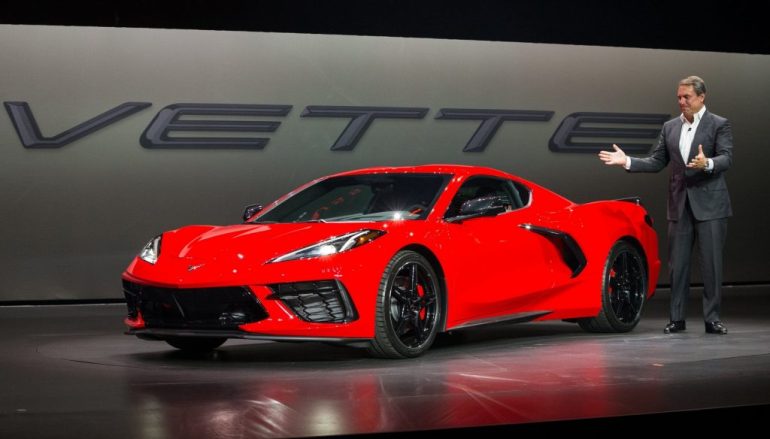 General Motors President Mark Reuss drives the 2020 Chevrolet Corvette Stingray onto the stage during its unveiling Thursday, July 18, 2019 in Tustin, California. The 2020 Stingray, the brand’s first-ever production mid-engine Corvette, features a new 6.2L Small Block V-8 LT2 engine producing 495 horsepower and 470 lb-ft of torque when equipped with performance exhaust. (Photo by Dan MacMedan for Chevrolet)
General Motors President Mark Reuss drives the 2020 Chevrolet Corvette Stingray onto the stage during its unveiling Thursday, July 18, 2019 in Tustin, California. The 2020 Stingray, the brand’s first-ever production mid-engine Corvette, features a new 6.2L Small Block V-8 LT2 engine producing 495 horsepower and 470 lb-ft of torque when equipped with performance exhaust. (Photo by Dan MacMedan for Chevrolet)
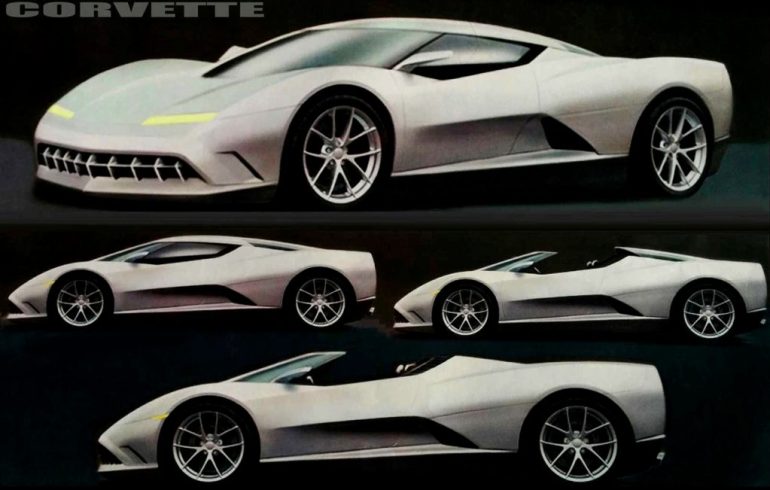 Early design sketches of the mid-engine Corvette.
Early design sketches of the mid-engine Corvette.
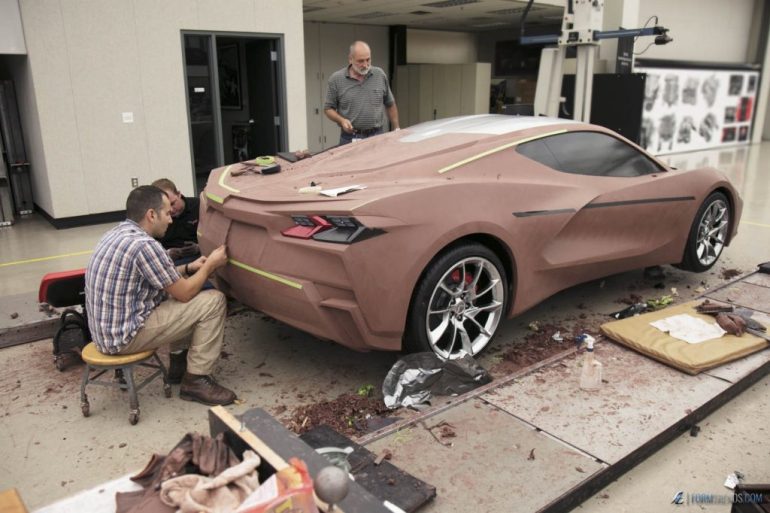 Full-scale clay model of the C8 Mid-Engine Corvette.
Full-scale clay model of the C8 Mid-Engine Corvette.
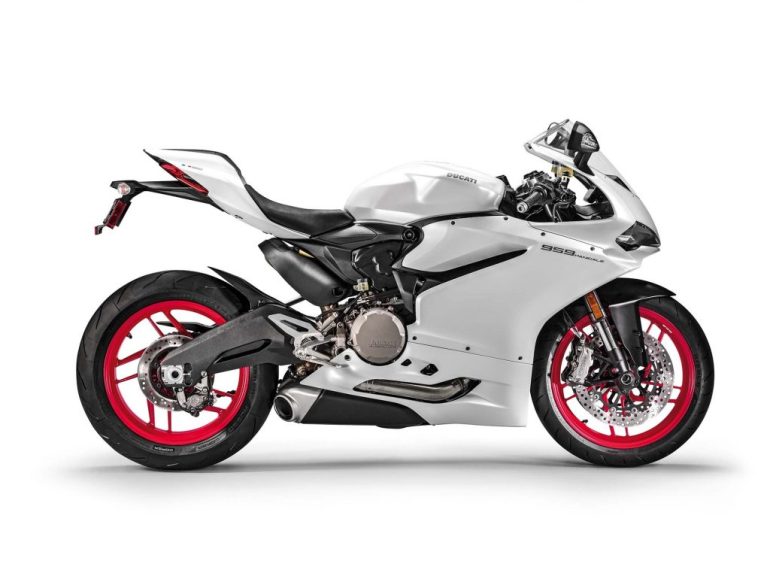 A 2016 Ducati 959 Panigale was one of two models used to inspire the engine design of the 2020 Mid-Engine Corvette.
A 2016 Ducati 959 Panigale was one of two models used to inspire the engine design of the 2020 Mid-Engine Corvette.
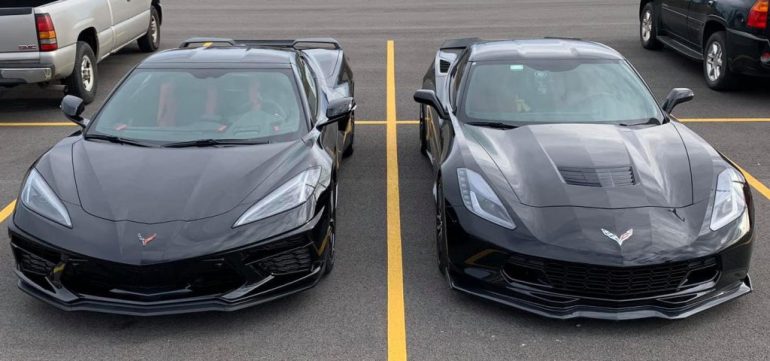 Although the mid-engine Corvette (left) is definitely a significant departure from its predecessors, there is no denying its Corvette heritage or its relationship to earlier models, such as the C7 to its right.
Although the mid-engine Corvette (left) is definitely a significant departure from its predecessors, there is no denying its Corvette heritage or its relationship to earlier models, such as the C7 to its right.
 Tadge Juechter, Corvette Chief Engineer.
Tadge Juechter, Corvette Chief Engineer.
 A Mid-Engine Corvette test mule, a C7 Corvette Coupe and a Porsche 911 are spotted during a testing session in May, 2018.
A Mid-Engine Corvette test mule, a C7 Corvette Coupe and a Porsche 911 are spotted during a testing session in May, 2018.
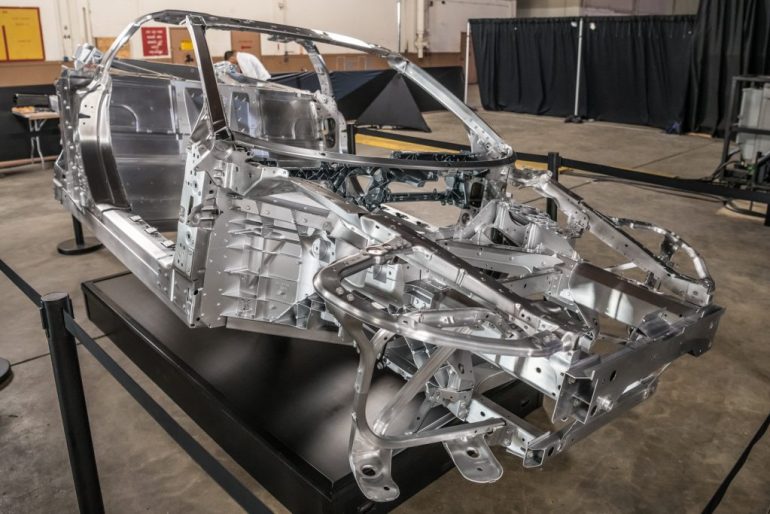 Chassis and composite sub-assembly of the eighth-generation Corvette.
Chassis and composite sub-assembly of the eighth-generation Corvette.
 The No. 3 C8.R Corvette Race Car in its official livery.
The No. 3 C8.R Corvette Race Car in its official livery.
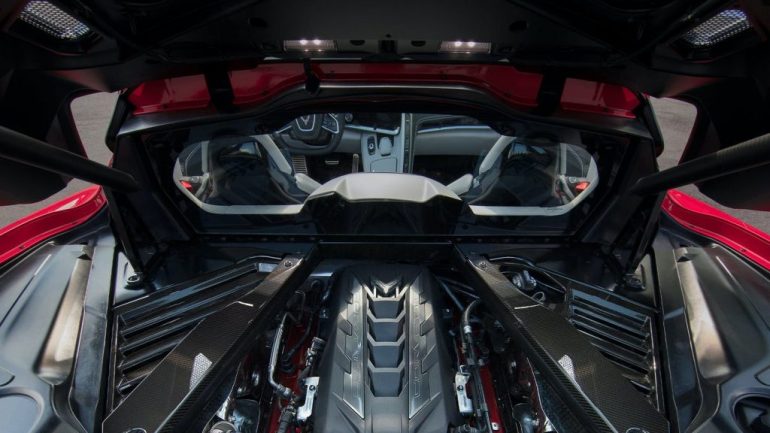 The LT2 engine – a 6.2-liter engine that produces 490 horsepower (and looks spectacular doing so) and the engine bay (with see-thru glass panel) that makes up the heart of the mid-engine Corvette.
The LT2 engine – a 6.2-liter engine that produces 490 horsepower (and looks spectacular doing so) and the engine bay (with see-thru glass panel) that makes up the heart of the mid-engine Corvette.
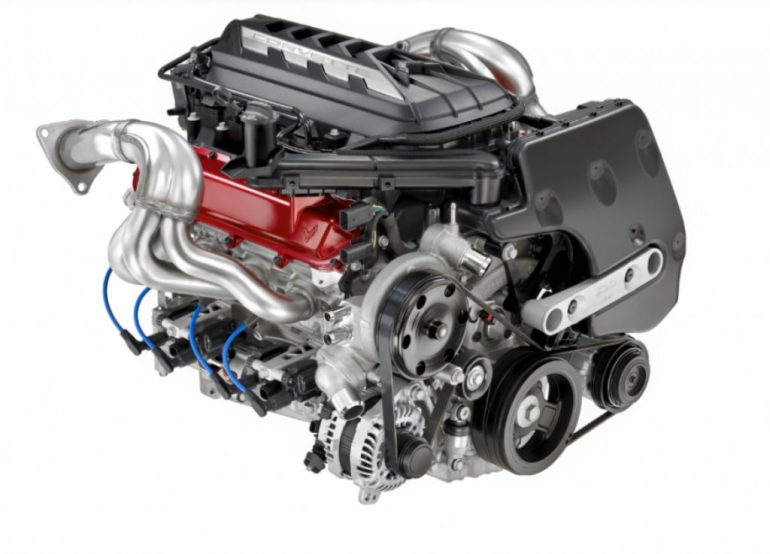 The LT2 – The 6.2L V8 engine created for use in the C8 Mid-Engine Corvette.
The LT2 – The 6.2L V8 engine created for use in the C8 Mid-Engine Corvette.
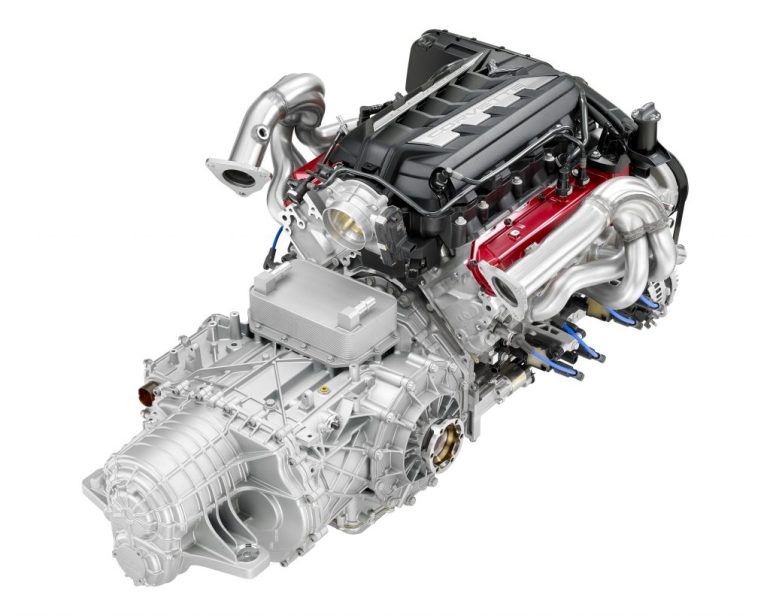 2020 Corvette Stingray’s LT2 V-8 engine and dual-clutch, 8-speed transmission
2020 Corvette Stingray’s LT2 V-8 engine and dual-clutch, 8-speed transmission
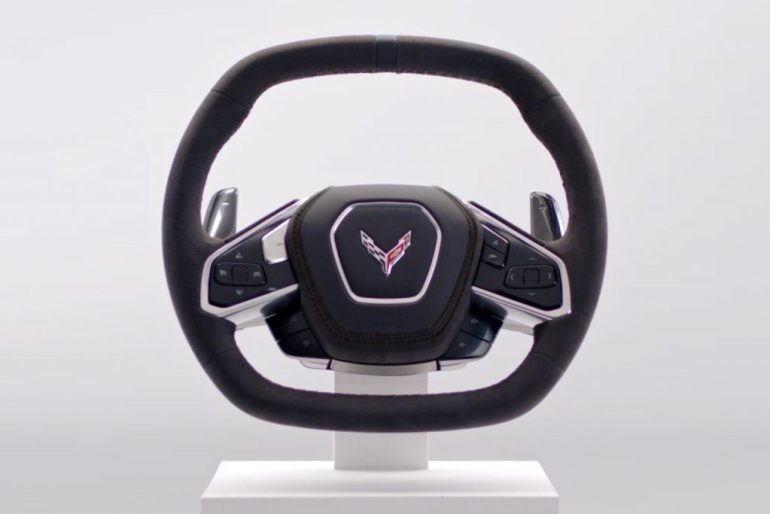 The new C8 Corvette steering wheel features factory-installed paddle shifters to further enhance the driving experience of these incredible machines.
The new C8 Corvette steering wheel features factory-installed paddle shifters to further enhance the driving experience of these incredible machines.
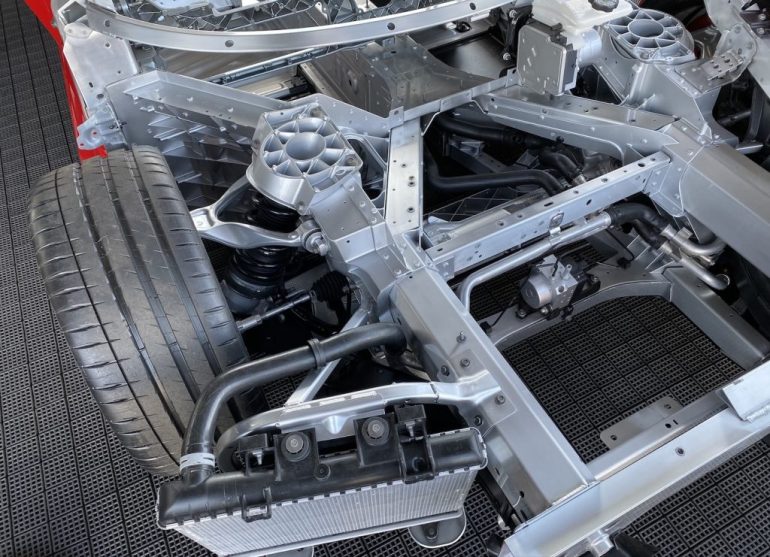 The C8 Mid-Engine Corvette features coil-over suspension at all four axles – a first for Corvette!
The C8 Mid-Engine Corvette features coil-over suspension at all four axles – a first for Corvette!
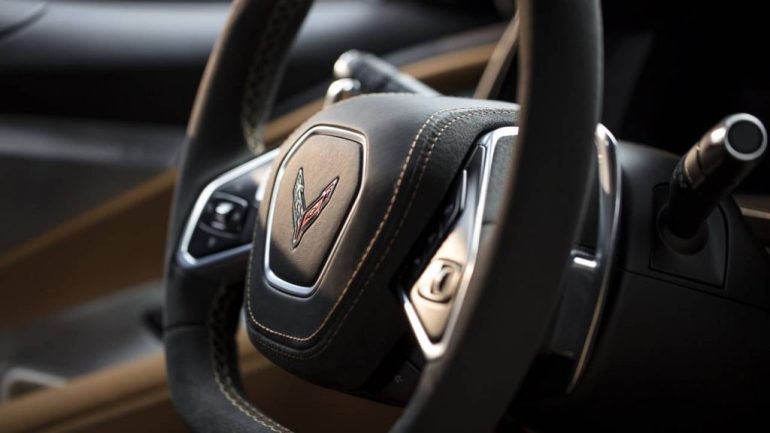 The steering wheel of the C8 Mid-Engine Corvette.
The steering wheel of the C8 Mid-Engine Corvette.
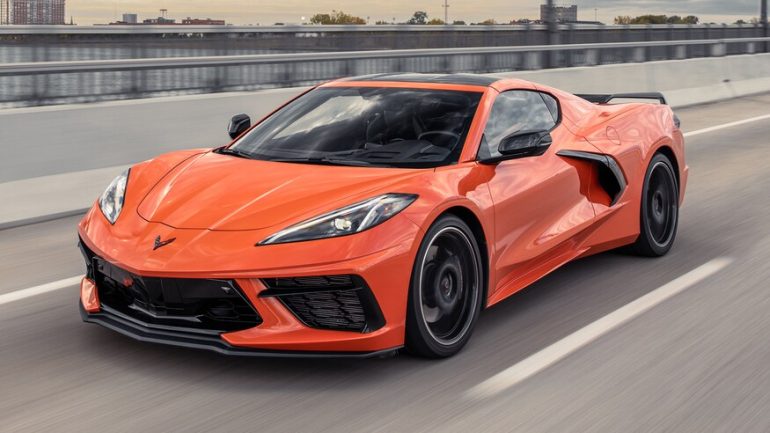 The 2020 Mid-Engine Corvette in Sebring Orange.
The 2020 Mid-Engine Corvette in Sebring Orange.
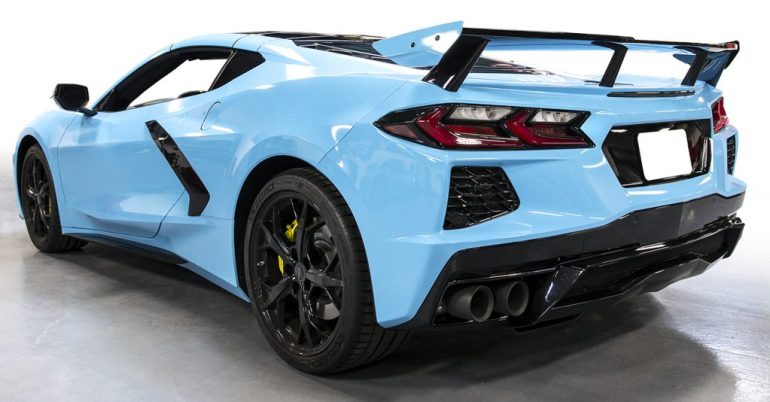 The 2020 Mid-Engine Corvette in Rapid Blue. Note the relocation of the exhaust from the center of the rear fascia to the outward corners.
The 2020 Mid-Engine Corvette in Rapid Blue. Note the relocation of the exhaust from the center of the rear fascia to the outward corners.
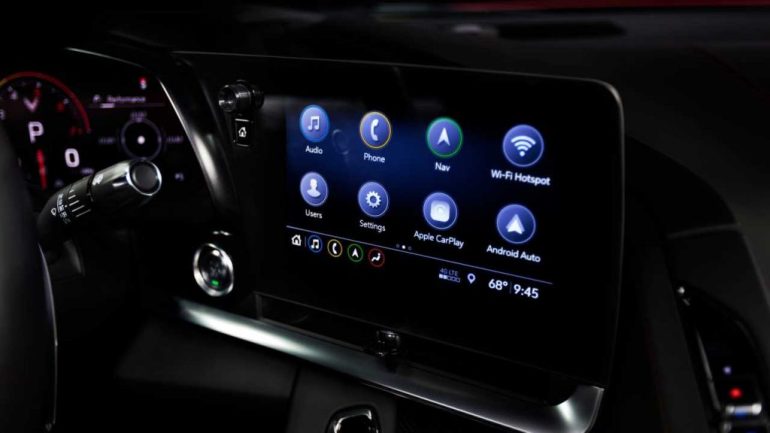 The infotainment center interface in the cockpit of the Mid-Engine Corvette.
The infotainment center interface in the cockpit of the Mid-Engine Corvette.
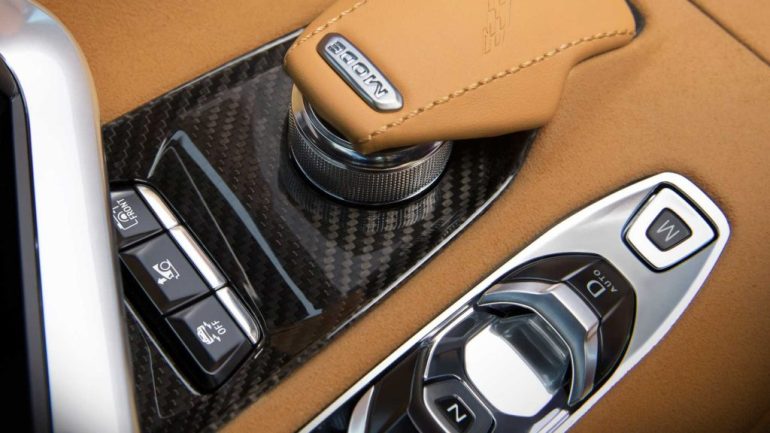 The Mid-Engine Corvette features a total of six drive modes that can be selected via a strategically placed roller dial in the center console.
The Mid-Engine Corvette features a total of six drive modes that can be selected via a strategically placed roller dial in the center console.
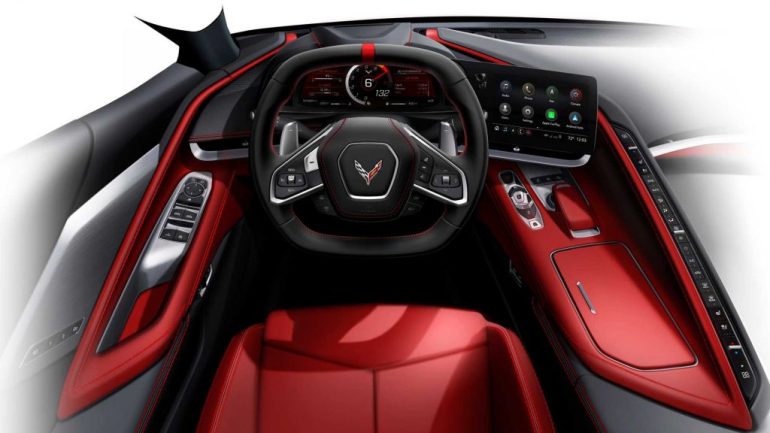 The cockpit of the all-new Mid-Engine Corvette.
The cockpit of the all-new Mid-Engine Corvette.
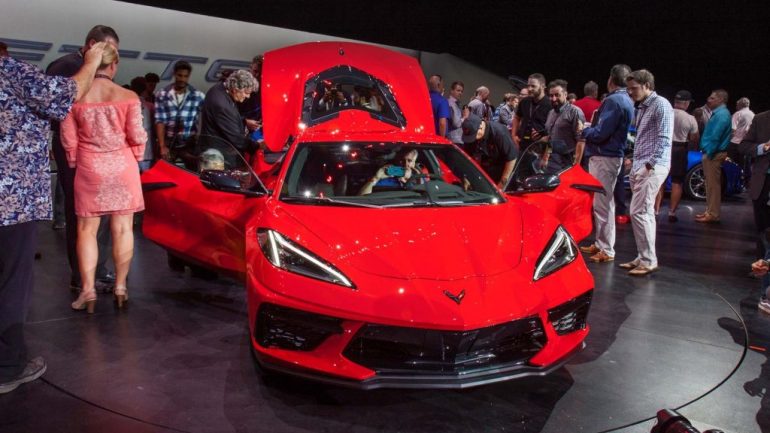 The 2020 Mid-Engine Corvette at the unveiling event on July 18, 2019.
The 2020 Mid-Engine Corvette at the unveiling event on July 18, 2019.
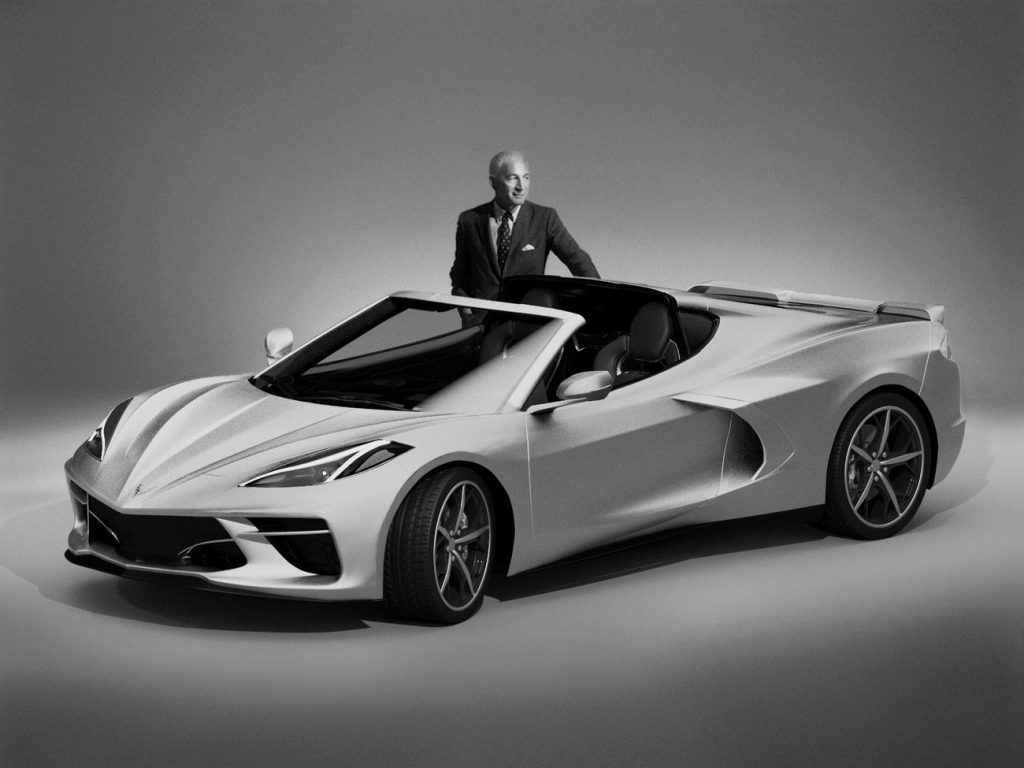 The dream becomes reality. Zora Arkus-Duntov stands beside the first-even Mid-Engine Corvette. While he never actually lived to see this day, we believe he would have been thrilled with this latest Corvette.
The dream becomes reality. Zora Arkus-Duntov stands beside the first-even Mid-Engine Corvette. While he never actually lived to see this day, we believe he would have been thrilled with this latest Corvette.
C8 Corvette Videos, Pictures & Wallpapers
Check out our stunning library of C8 Corvette videos and images. Thousands to enjoy.
The C8 Corvette Newsfeed
Get all the latest news stories, upcoming auctions, cool cars for sale, prices, videos and more about the C8 Chevrolet Corvette! The latest headlines here.
C8 Corvette Technical Research
Production and sales numbers, order guides and sales brochures, we have more C8 Corvette research than you could ever want.


